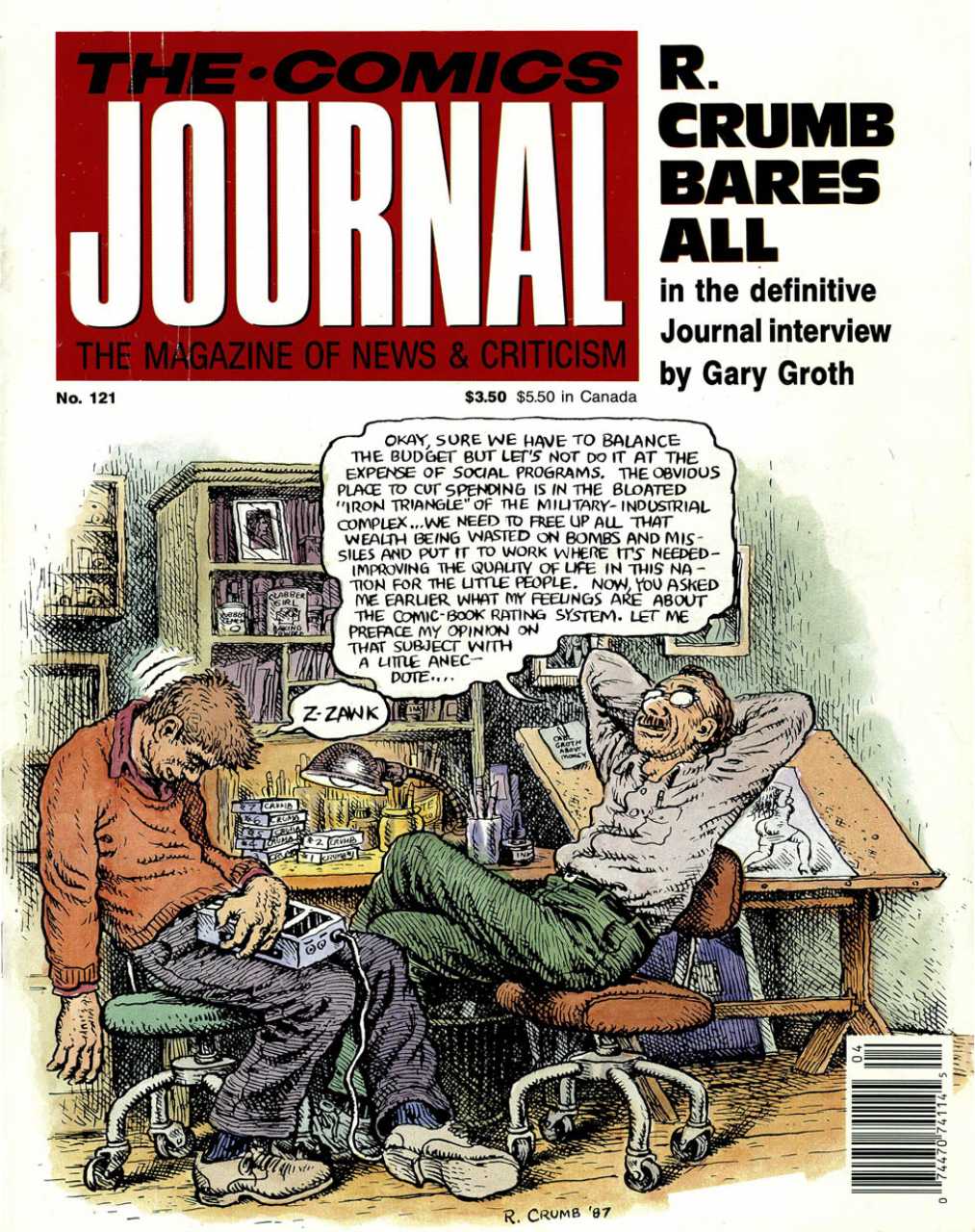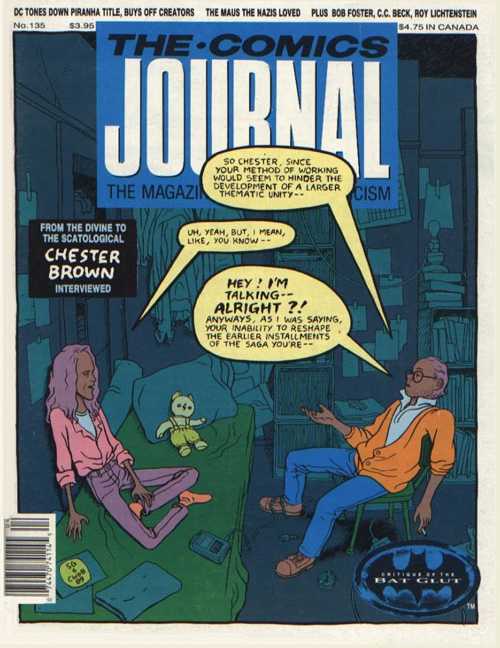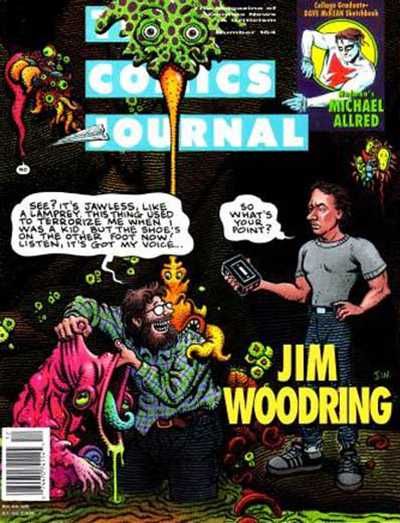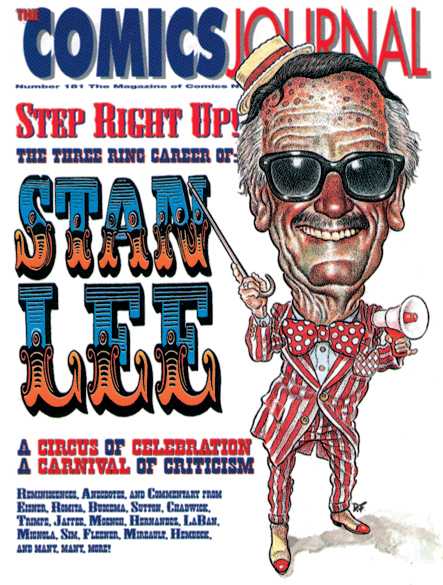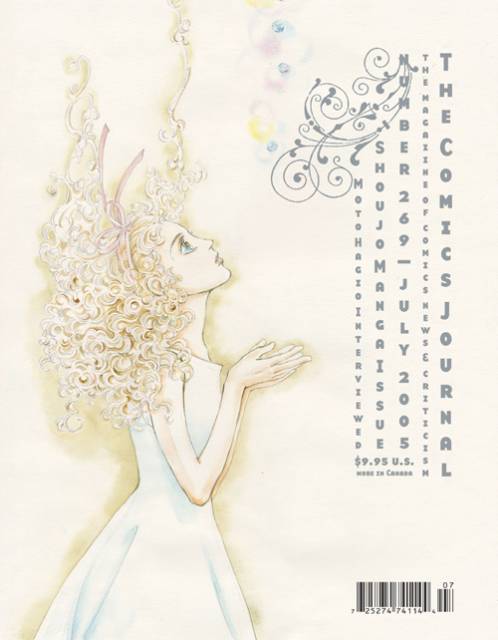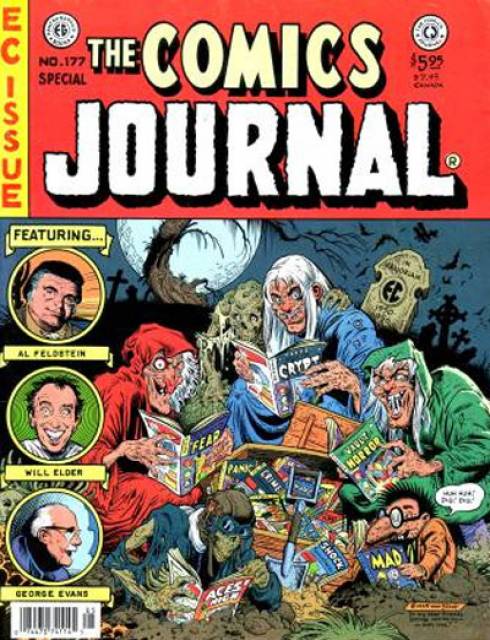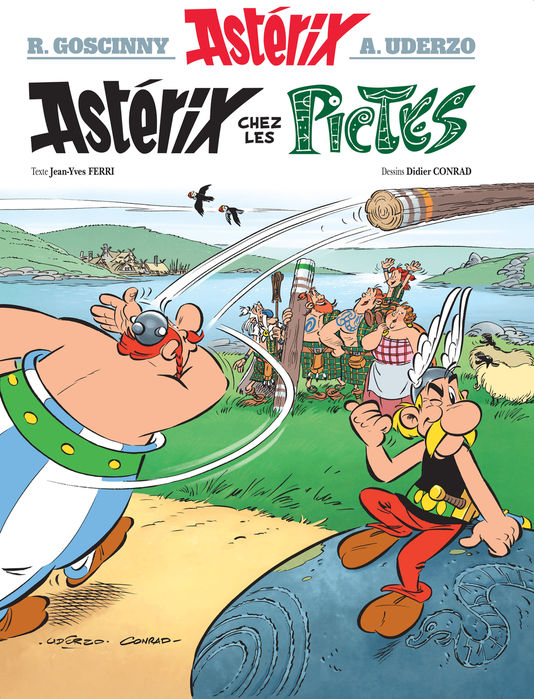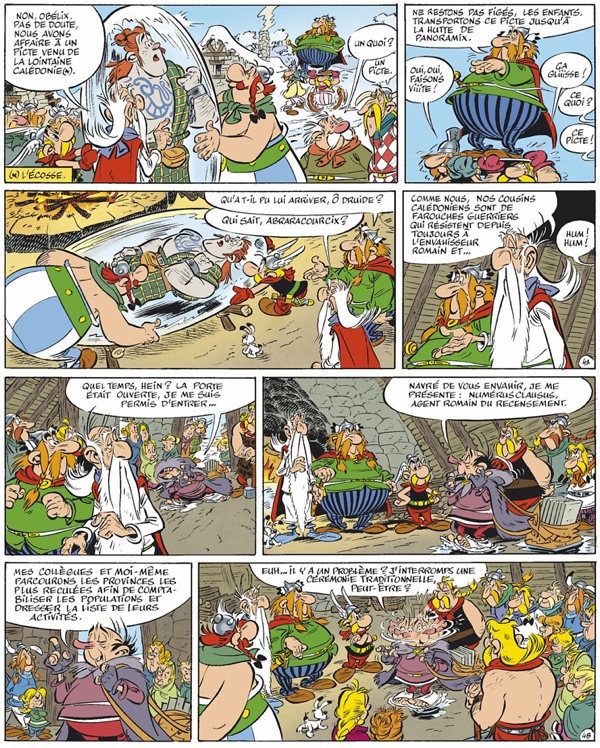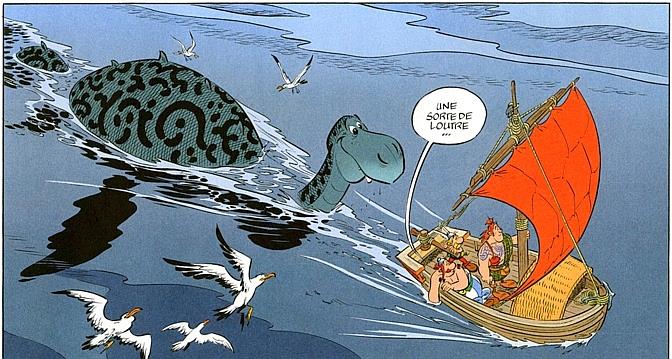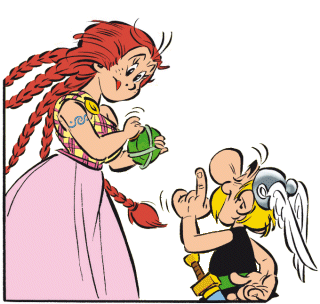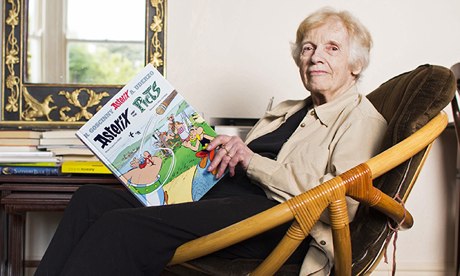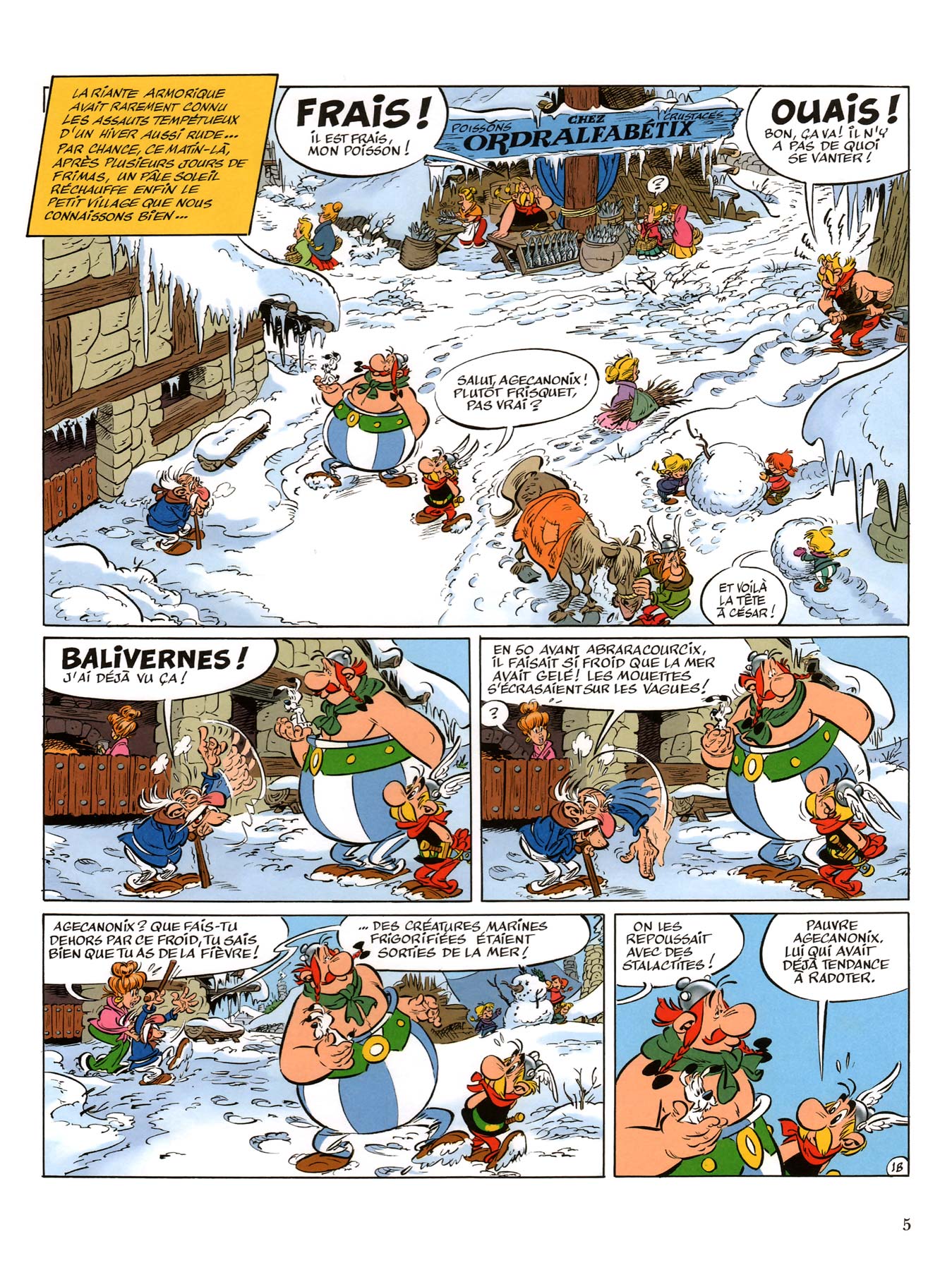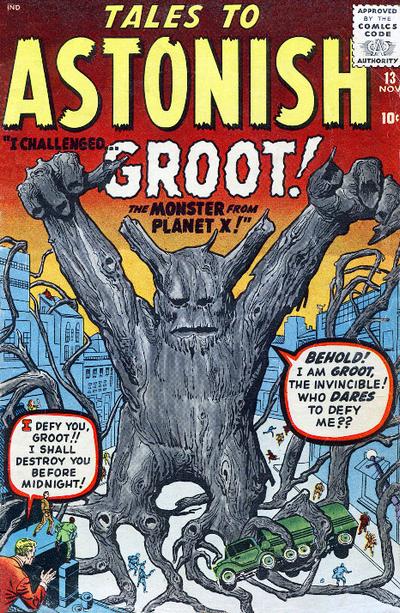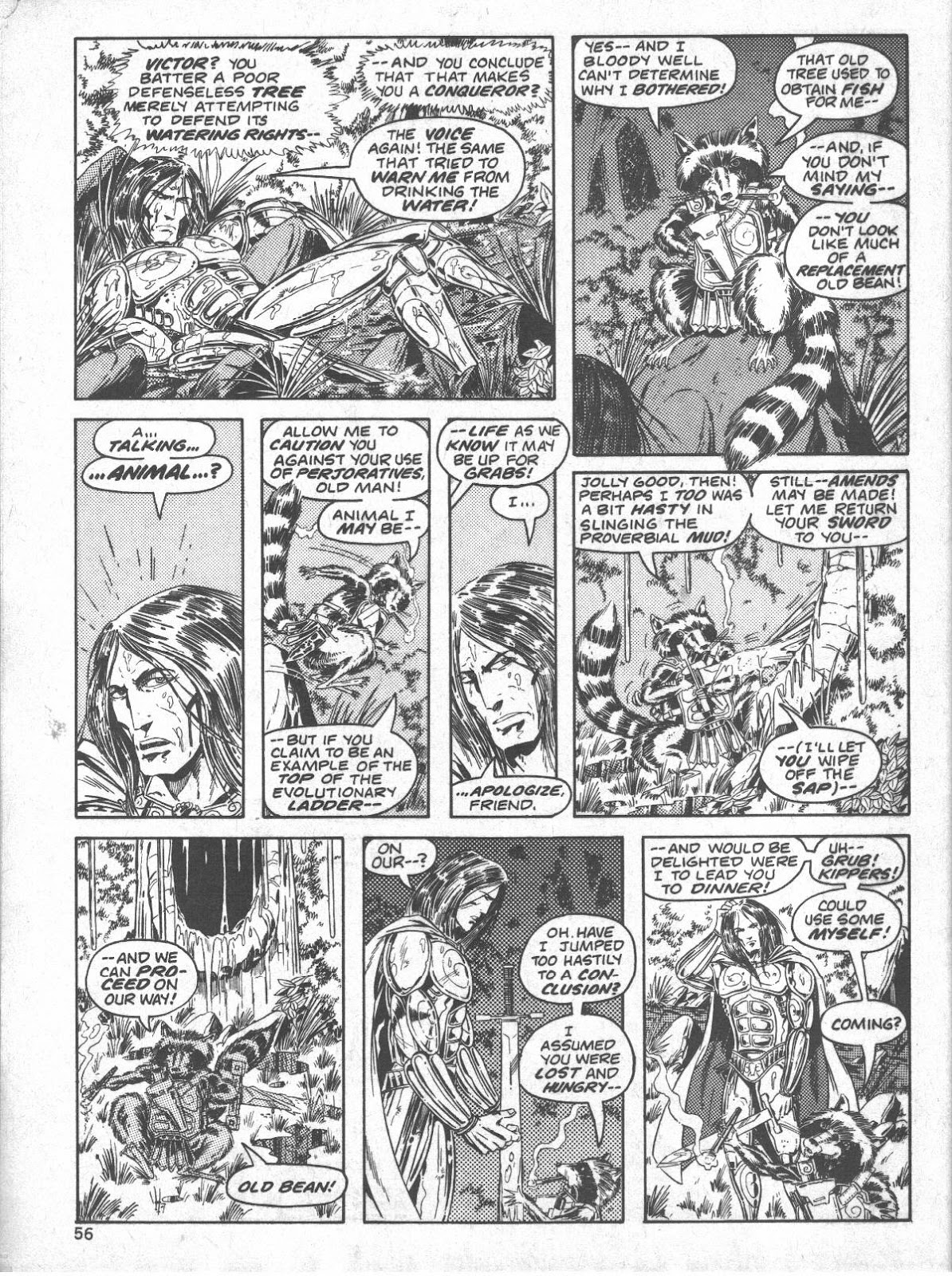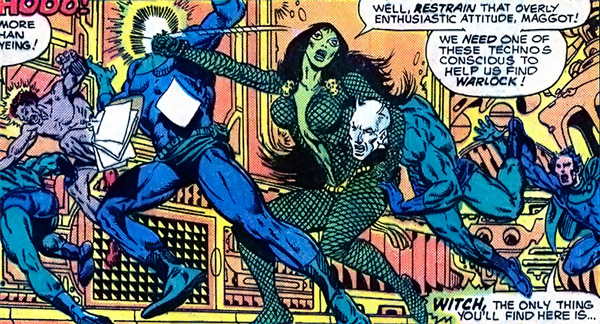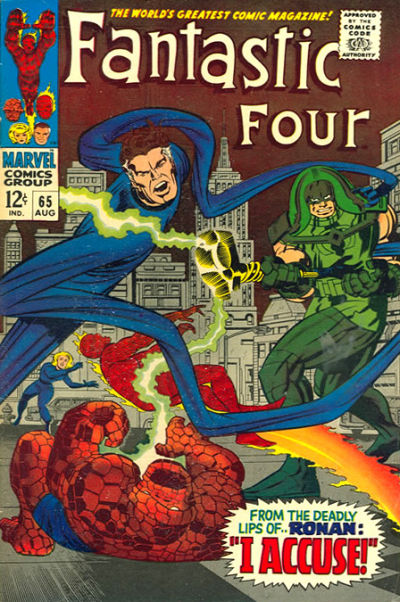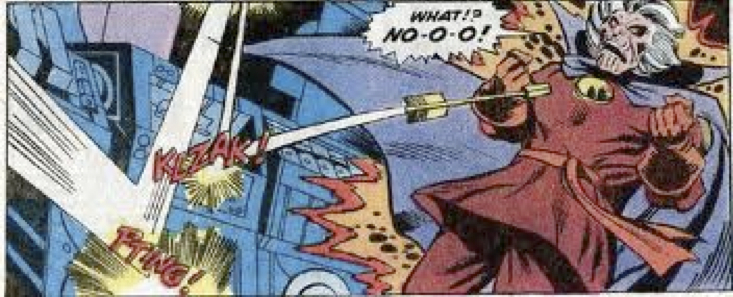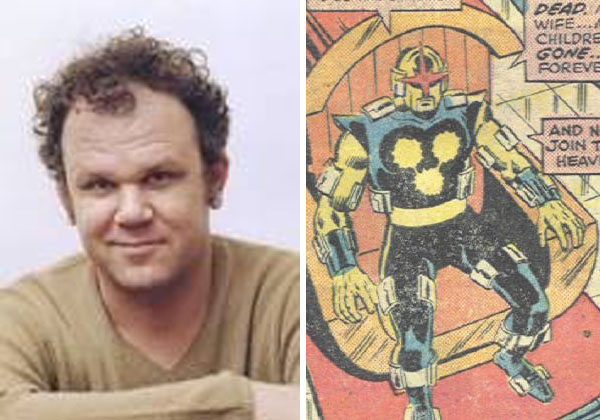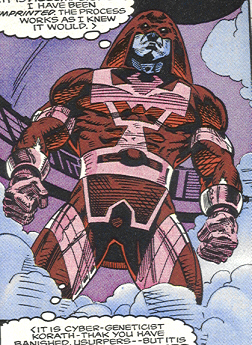Editor’s Note: This post was created in consultation with Chris Gavaler. Chris’ introduction to Atomas is here.
[Note from Alex Buchet: All comments in italics below are from me. Click on images to enlarge them.]
Mon Journal No. 70, episode 1:
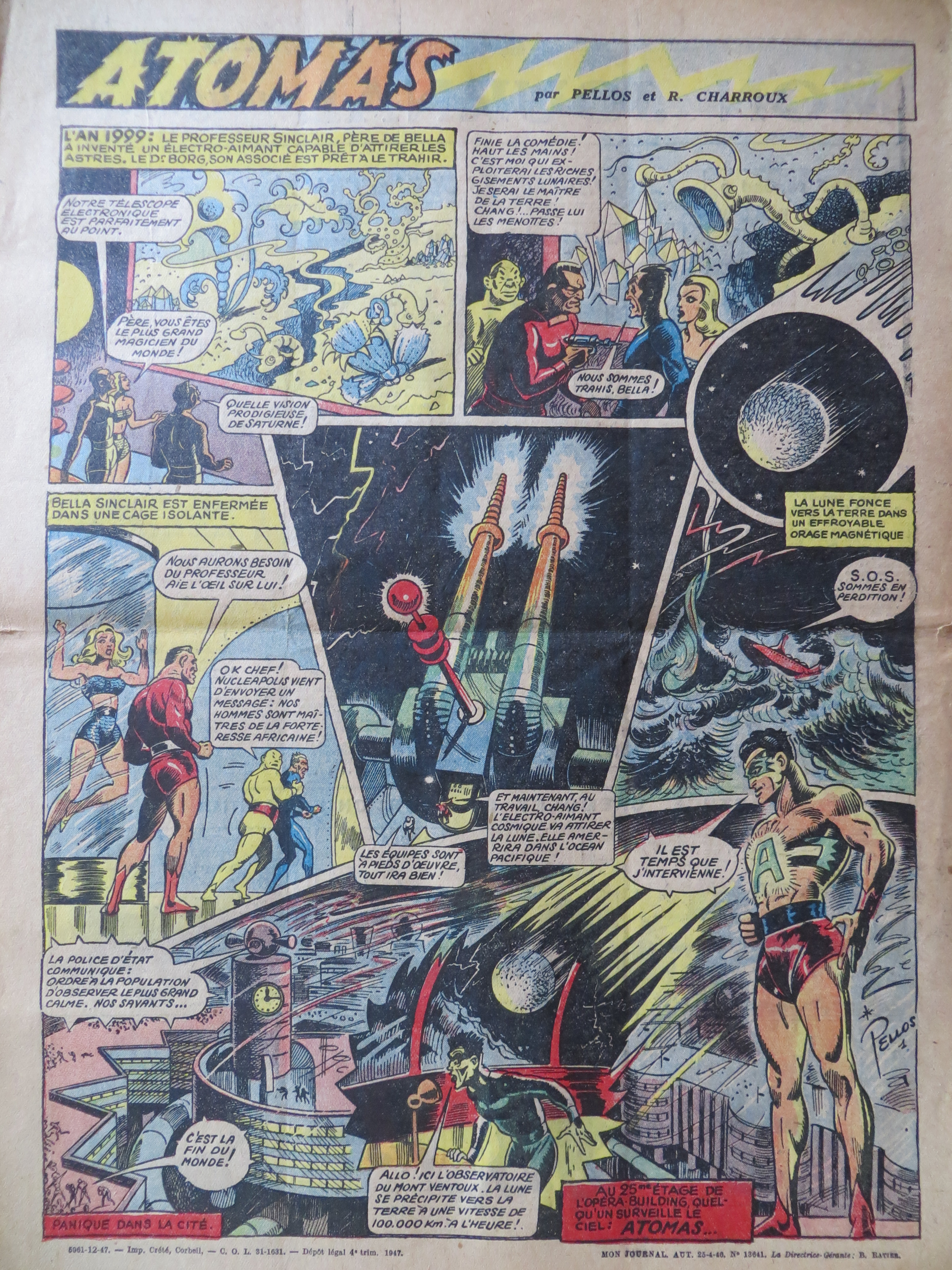
Panel 1
Caption:
The year 1999: Professor Sinclair, father of Bella, has invented an electro-magnet able to attract the stars. Dr Borg, his associate, is ready to betray him.
Sinclair: Our electronic telescope is perfected.
Bella: Father, you’re the world’s greatest magician!
Borg: What a prodigious vision of Saturn!
Panel 2
Borg: Enough playacting! Hands up! I’m the one who’ll exploit the mineral wealth of the moon! I shall be the master of the world! Chang!… Put the cuffs on him!
Sinclair: We are betrayed, Bella!
Panel 3
Caption:
Bella Sinclair is shut up in an isolation cage.
Borg: We’ll need the Professor. Keep an eye on him!
Chang: OK chief! Nucleopolis has just sent a message! Our men are masters of the American fortress!
Panel 4
Chang: The teams are hard at work! Everything’ll go right!
Borg: And now, to work, Chang! The cosmic electro-magnet will attract the Moon. It’ll splash down in the Pacific Ocean!
Panel 5 (insert)
Caption:
The Moon heads for the Earth in a horrific magnetic storm
Panel 6
Ship: S.O.S We are in hazard!
Panel 7
Loudspeaker: The State Police communicates: The population is ordered to observe the utmost calm. Our scientists…
Panel 8 (insert)
Astronomer: Hello! The Mont Ventoux Observatory here. The moon is hurtling towards the Earth at a speed of 100 000 kilometers per hour!
Panel 9:
Atomas: It’s time for me to intervene!
Caption:
On the 25th floor of the Opera Building, someone is watching the sky! Atomas…
[This seems to bring on the crazy like Fletcher Hanks. Note that the background seems to be American — since Jules Verne, America was always the home of futurism for the French. PS Opera Building is in English in the final caption.That said, Mont Ventoux is a real French observatory.]
Mon Journal No. 71, episode 2:
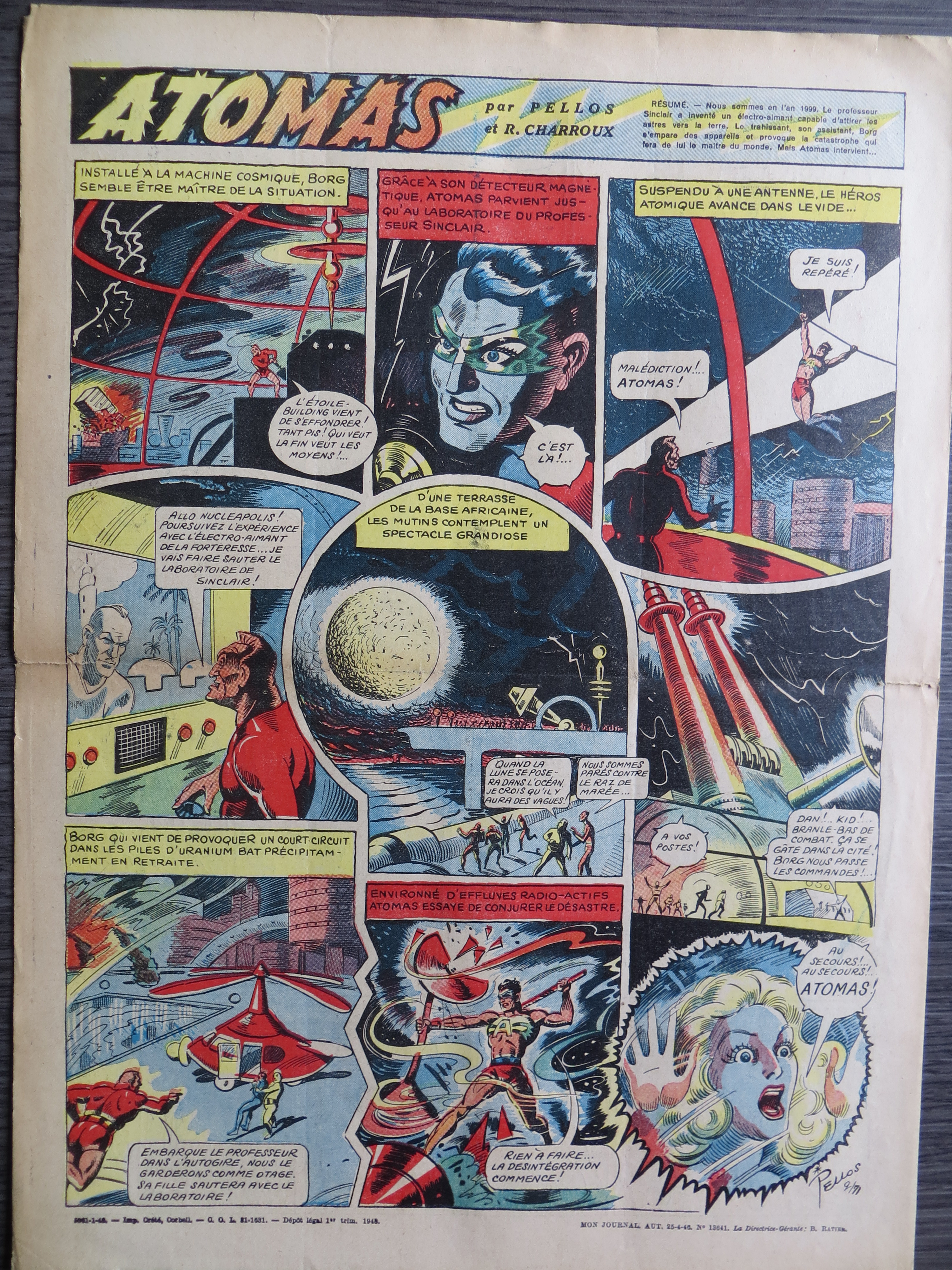
Panel 1
Caption :
Installed at the cosmic machine, Borg seems master of the situation.
Borg: The Star Building has just collapsed! Too bad! The end justifies the means!
Panel 2
Caption:
Thanks to his magnetic detector, Atomas manages to get right to Profesor Sinclair’s laboratory
Atomas: It’s here!
Panel 3
Caption:
Hanging from an antenna, the atomic hero advances through empty space
Atomas: I’ve been spotted!
Borg: Curses! It’s Atomas!
Panel 4
Borg: Hello Nucleapolis! Continue the experiment with the fortress’s electro-magnet…I’m going to blow up Sinclair’s laboratory!
Panel 5
Caption:
From a terrace at the African base, the mutineers gaze on a grand spectacle
Mutineer: When the Moon lands in the ocean, I believe it’ll make waves!
Accomplice:We’re prepared for the tidal wave…
Panel 6
Mutineer: To your posts!
Mutineer 2: Dan!..Kid!…Battle stations, all. Things are going wrong in the city! Borg’s transferring controls to us!
Panel 7
Caption:
Borg, who’s just caused a short-circuit in the uranium piles, beats a hasty retreat.
Borg: Load the Professor into the autogiro, he’ll be our hostage. His daughter will blow up with the laboratory!
Panel 8
Caption:
Surrounded by radioactive effluvia, Atomas tries to avert the disaster.
Atomas: It’s no use, the disintegration is starting!
Panel 9
Bella: Help! Help! Atomas!
[The name Atomas is certainly a riff on the far more famous Fantomas.” –as” isn’t a normal French suffix; but “as” translates as ace, both the card and in the sense of a supremely competent person. So we’re reading about Atom Ace, name inspired by Phantom Ace!]
Mon Journal No. 72, episode 3:
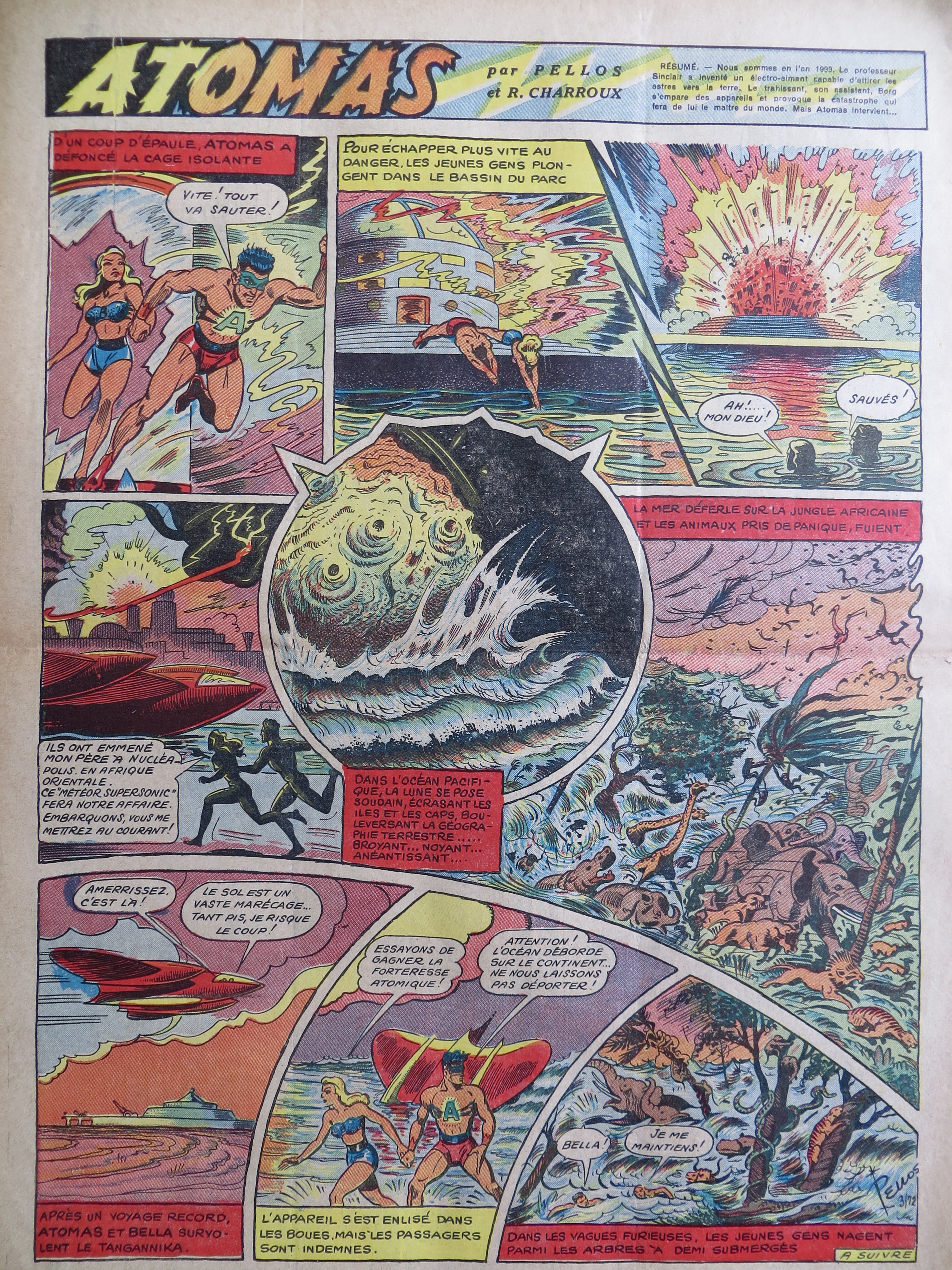
Panel 1
Caption :
With a blow from his shoulder, Atomas has broken through the isolation cage
Atomas: Quick! Everything’s going to blow up!
Panel 2
Caption:
To more speedily avoid danger, the two young people dive into the park’s basin
Panel 3
Bella: Ah! My God!
Atomas: Saved!
Panel 4
Bella: They took my father to Nucleapolis, in East Africa. This ‘Supersonic Meteor’ will
do for us. Let’s board, you can fill me in!
Panel 5
Caption:
In the Pacific Ocean, the Moon suddenly splashes down, crushing the capes and islands, throwing terrestrial geography into chaos…grinding…drowning…destroying…
Panel 6
Caption:
The sea overwhelms the African jungle, and the panic-stricken animals flee.
Panel 7
Bella: Splash down, it’s here!
Atomas: The land’s a huge swamp. Too bad, I’ll risk it!
Caption:
After a record-breaking trip, Atomas and Bella are flying over Tanganyika.
Panel 8
Bella: Let’s try to reach the atomic fortress!
Atomas: Careful! The ocean’s overflowing the continent..let’s not get swept away!
Caption:
The vehicle is stuck in the mud, but the passengers are uninjured.
Panel 9
Atomas: Bella!
Bella: I’m keeping afloat!
Caption:
In the furious waves, the young people swim amidst the half-sunken trees…
[The insanity just keeps ramping up! Note the mention of Tanganyika, which in 1947 was still a colony and hadn’t yet merged with Zanzibar to form the new state of Tanzania.]
Mon Journal No. 73, episode 4:
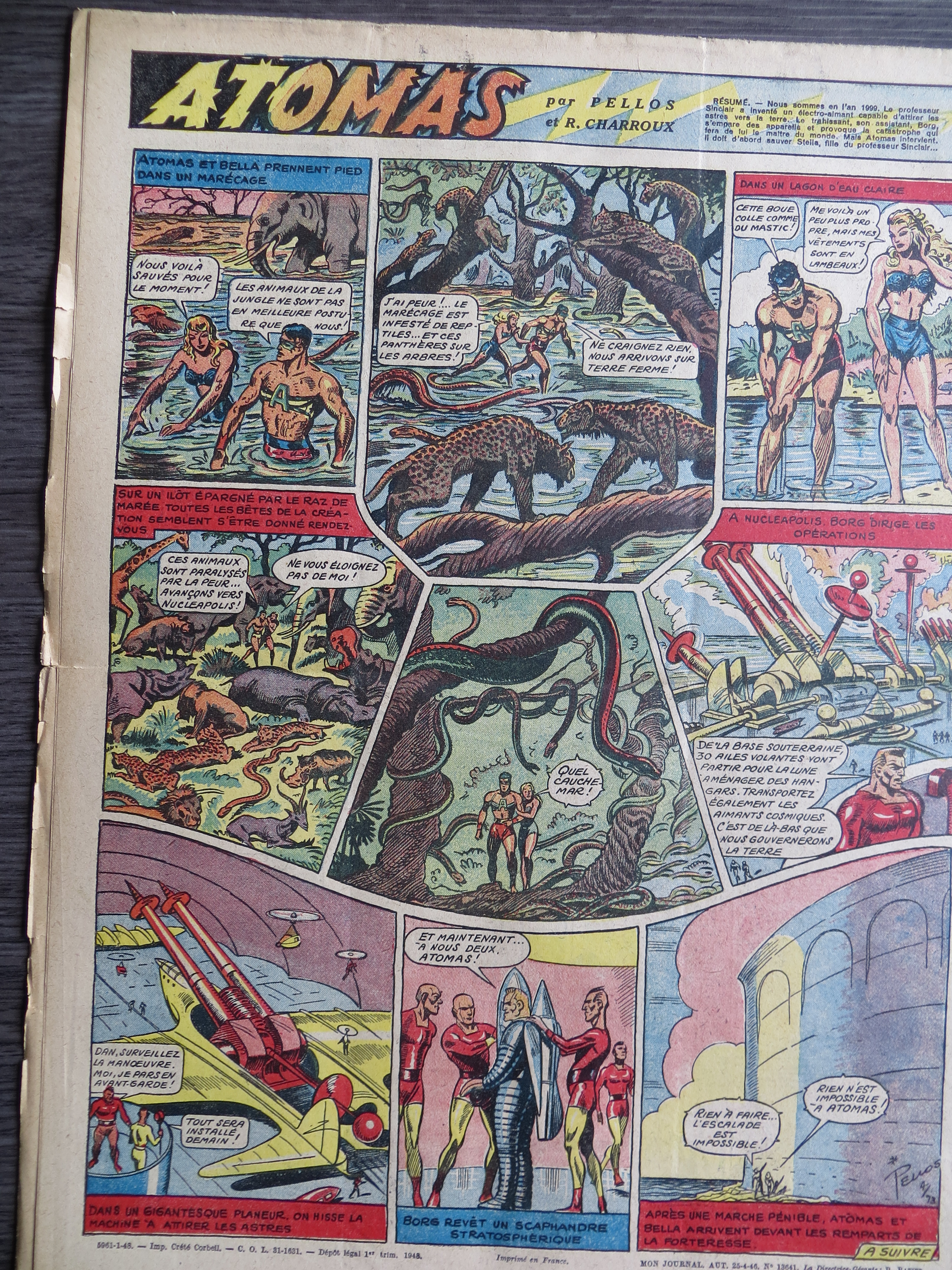
Panel 1
Caption :
Atomas and Bella find footing in a swamp.
Bella: We’re saved for the moment!
Atomas: The jungle animals aren’t any better off than we!
Panel 2
Bella: I’m afraid! The swamp is infested with reptiles! And those panthers in the trees!
Atomas: Fear nothing, we’re getting to solid ground!
Panel 3
Caption:
In a lagoon of clear water
Atomas: This mud sticks like putty!
Bella: We’re a little cleaner, but my clothes are in rags!
Panel 4
Caption:
On an islet spared by the tidal wave all the animals in creation seem to have rendez-voused…
Atomas: All these animals seem paralyzed by fear …forward to Nucleapolis!
Bella: Don’t stray away from me!
Panel 5
Bella: What a nightmare!
Panel 6
Caption:
In Nucleapolis Borg directs operations
Borg: From the underground base, 30 Flying Wings will take off for the Moon to set up hangars. Transport the cosmic magnets, too. It’s from there that we shall govern Earth.
Panel 7
Borg: Dan, watch over the work. I’m going in the vanguard.
Dan: Everything will be set up by tomorrow!
Caption:
In a gigantic glider, the machine for attracting the stars is hauled aboard.
Panel 8
Borg: And now, it’s between you and me, Atomas!
Caption:
Borg dons stratospheric armor
Panel 9
Atomas: Nothing doing, the climb is impossible!
Bella: Nothing is impossible for Atomas!
Caption:
After a hard trek, Atomas and Bella arrive before the ramparts of the fortress.
[Pity, Bella reverts from a capable and brave adventurer to the standard whiny, shrinking female – one who typically complains about her wardrobe and showers the man with adoring flattery.]
Mon Journal No. 74, episode 5:
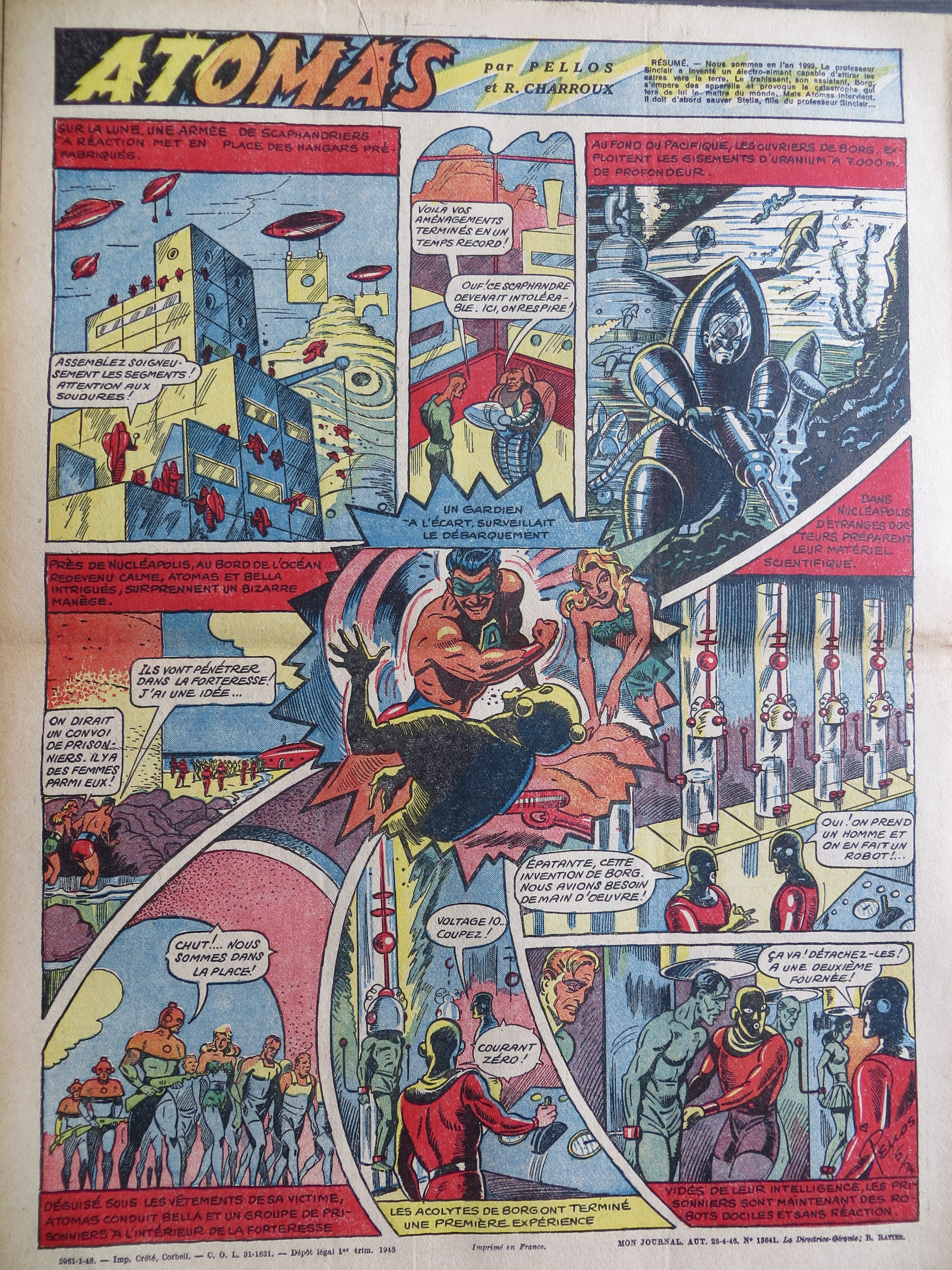
Panel 1
Caption :
On the Moon an army of jet-propelled armored men set up pre-fabricated hangars
Foreman: Assemble the segments carefully! Mind the welds!
Panel 2
Dan: Here are your installations assembled in record time!
Borg: Oof! This armor’s become intolerable! Here we can breathe!
Panel 3
Caption:
At the bottom of the Pacific, Borg’s laborers exploit the uranium at a depth of 2000 meters
Panel 4
Near Nucleapolis, by an ocean once more tranquil, Atomas and Bella are intrigued as they watch bizarre goings-on.
Bella: It looks like a convoy of prisoners. There are women among them!
Atomas: They’re going to enter the fortress. I have an idea!
Panel 5
Caption:
To one side, a guard was watching the disembarkation.
Panel 6
Caption:
In Nucleapolis, strange doctors prepare their equipment
Doc 1: Terrific, this new invention of Borg’s. We needed manpower!
Doc 2: Yes! We take a man and make him a robot!
Panel 7
Atomas: Shh! We’re in!
Caption:
Disguised in the clothes of his victim, Atomas leads Bella and a group of prisoners into the fortress.
Panel 8
Doc 1: Voltage 10…Cut!
Doc 2: Zero current!
Caption:
Borg’s acolytes have finished a first experiment.
Panel 9
Doc 1: That’s fine! Detach them! Prepare a second shift!
Caption:
Emptied of their intelligence, the prisoners are now docile, reactionless robots.
[I like how Borg whines about how stuffy his suit is. You don’t hear Iron Man complain, do you? Meanwhile, Bella is treated like an idiot who has to be shushed in the enemy’s presence, as though she’d start blurting out her hero’s secret plans at any moment.]
Mon Journal No. 75, episode 6:
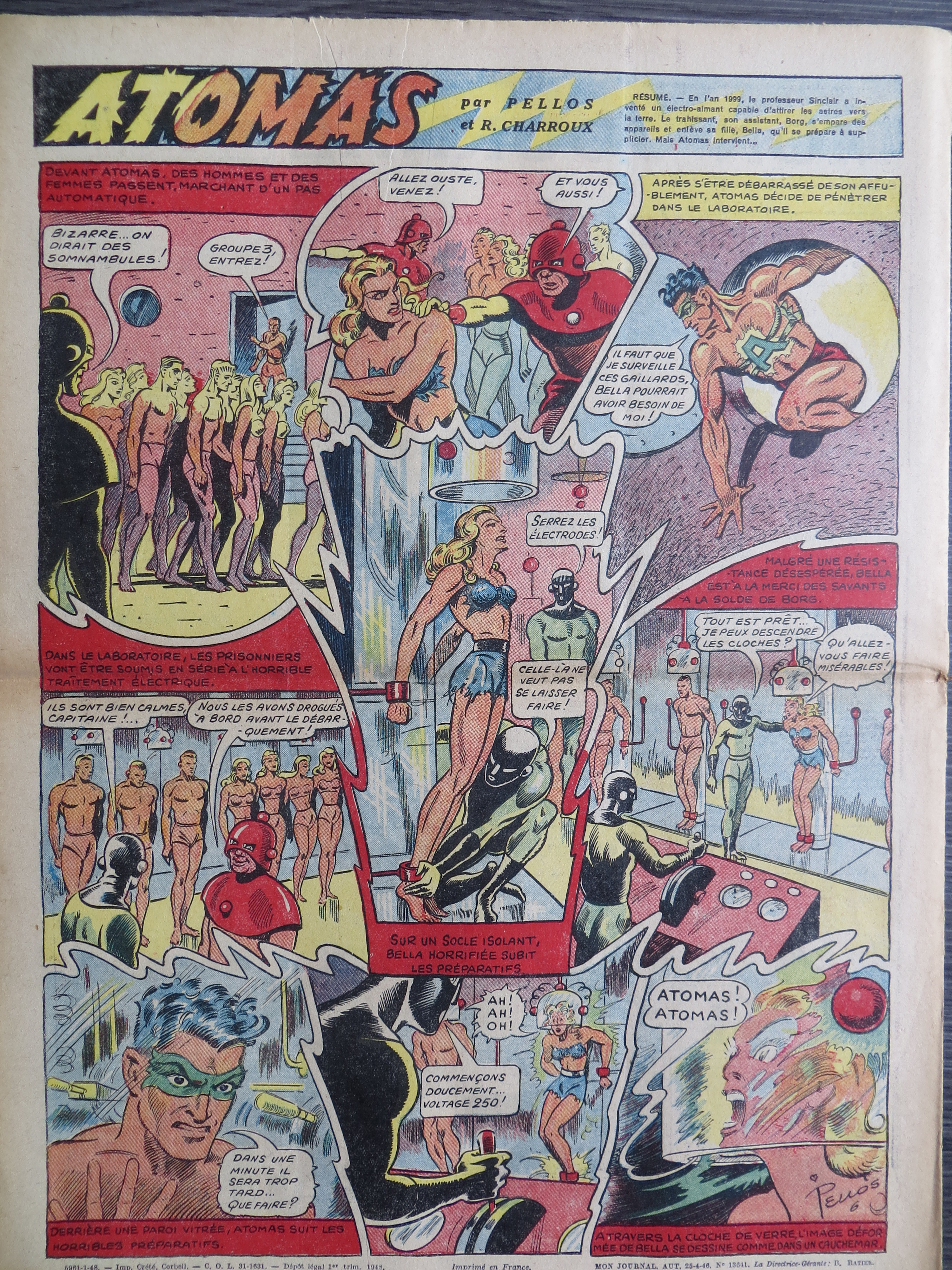
Panel 1
Caption :
Before Atomas, men and women pass by, walking in an automatic way…
Atomas: How bizarre…they look like sleepwalkers.
Guard: Group 3, come in!
Panel 2
Caption:
Guard 1: Hop to it, come on!
Guard 2: And you too!
Panel 3
Caption:
After getting rid of his disguise, Atomas decides to enter the laboratory
Atomas: I’ve got to watch these fellows, Bella might need me!
Panel 4
Caption:
In the laboratory, the prisoners will be forced to undergo the horrible electric treatment
Doc: They’re really calm, Captain!
Captain: We drugged them on board before disembarking!
Panel 5
Doc 1: Tighten the electrodes!
Doc 2: This one’s not going along easily!
Caption:
On an insulated platform, a horrified Bella undergoes the preparation.
Panel 6
Caption:
Despite her desperate resistance, Bella is at the mercy of the scientists in Borg’s pay.
Doc: Everything’s ready. Can I lower the bell-jars?
Bella: What are you going to do, you wretch?
Panel 7
Atomas: In a minute it’ll be too late. What to do?
Caption:
Behind a glass wall, Atomas follows the horrible preparations.
Panel 8
Bella: Ah! Ah! Oh!
Doc: Let’s start out slowly…voltage 250!
Panel 9
Bella: Atomas! Atomas!
Caption: Through the gass bell-jar, the deformed face of Bella seems drawn from a nightmare.
[ I agree with that last caption. A pretty powerful image!]
Mon Journal No. 76, episode 7:
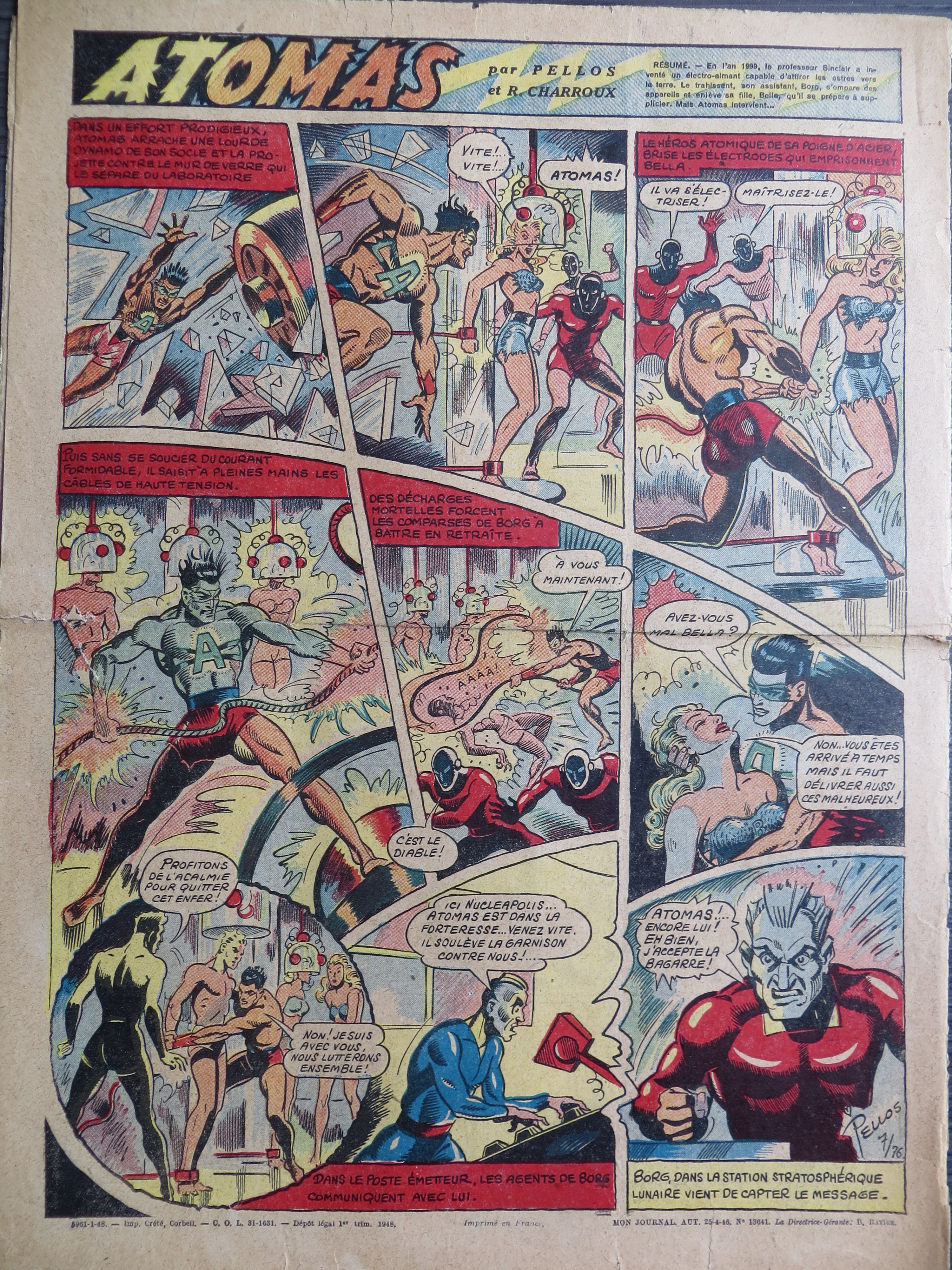
Panel 1
Caption:
With a prodigious effort, Atomas tears a heavy dynamo from its base and hurls it against the wall of glass that separates him from the laboratory!
Panel 2
Bella: Quick! Quick!
Doc: Atomas!
Panel 3
Caption:
The atomic hero with his steely grip breaks the electrodes binding Bella
Doc 1: He’s going to electrify himself!
Doc 2: Overpower him!
Panel 4
Caption:
Then with no care for the formidable current he grasps with full handfuls the high-voltage cables.
Panel 5
Caption:
Lethal discharges force the accomplices of Borg to beat a retreat.
Atomas: Your turn, now!
Doc: It’s the Devil!
Panel 6
Atomas: Are you hurt, Bella?
Bella: No, you got here in time…but we must free these unfortunates too!
Panel 7
Freed captive: Let’s take advantage of this quiet moment to leave this Hell!
Atomas:No! I’m with you, we’ll fight together!
Panel 8
Henchman: Nucleapolis here…Atomas is in the fortress…Come quickly, he’s making the garrison rise up against us!
Caption:
In the radio room, Borg’s agents communicate with him.
Panel 9
Borg: Atomas! Him again! All right, I accept the brawl!
Caption:
Borg, in the lunar stratospheric station, has received the message.
[Seem to be some swipes from Burne Hogarth’s Tarzan here. Actually, I’ll bet the major influences on Pellos’ style are the American strips Flash Gordon—“Guy L’Eclair” in French—and Brick Bradford – “Luc Bradefer”.]
Mon Journal No. 77, episode 8:
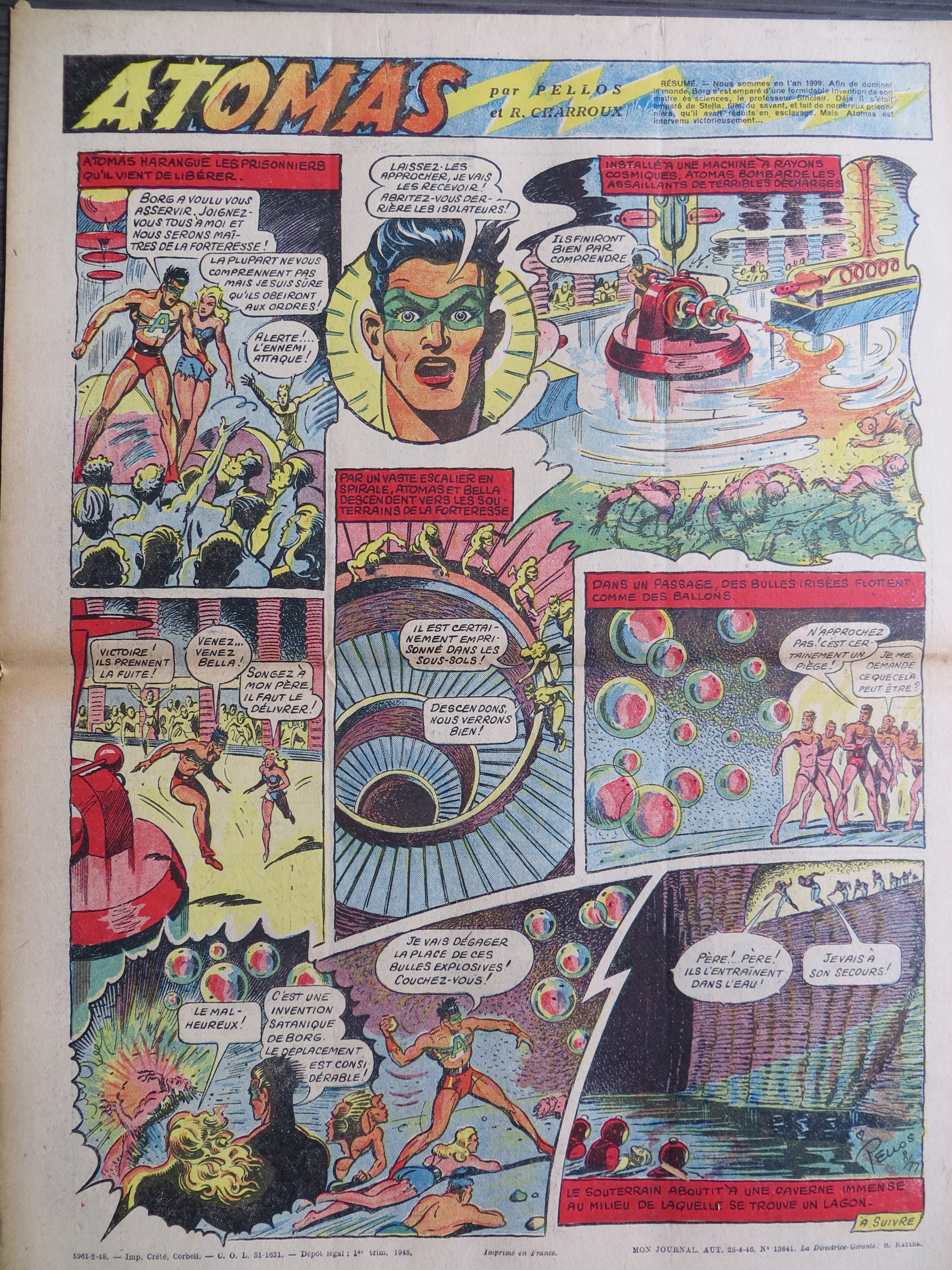
Panel 1
Caption:
Atomas harangues the prisoners he has just freed.
Atomas: Borg tried to enslave you. All of you join me and we’ll be masters of the fortress!
Bella: Most of them don’t understand you but I’m sure they’ll obey your orders!
Ex-captive: Alert! The enemy’s attacking!
Panel 2
Atomas: Let them approach, I’ll be their host! Take cover behind the insulators!
Panel 3
Caption:
Manning a cosmic ray machine, Atomas bombards the assaillants with terrible discharges!
Atomas: They’ll get the idea real soon!
Panel 4
Ex-captive: Victory! They’re fleeing!
Atomas: Come on…come on, Bella!
Bella: Think of my father, he must be freed!
Panel 5
Caption:
Down a vast spiral staircase, Atomas and Bella descend towards the underground parts of the fortress.
Bella: He’s sure to be imprisoned in the below-ground levels!
Atomas: Let’s go down, we’ll find out!
Panel 6
Caption:
In one passage, iridescent bubbles float like balloons.
Atomas: Don’t go near them! It’s certainly a trap!
Bella: I wonder what that could be?
Panel 7
Bella: The poor man!
Atomas: It’s a satanic invention of Borg’s. The displacement is considerable!
Panel 8
Atomas: I’m going to rid the area of these explosive bubbles! Get down flat!
Panel 9
Bella: Father! Father! They’re dragging him into the water!
Atomas: I’m going to his rescue!
Caption:
The underground passage ends in an immense cavern in the middle of which is a lagoon
[Whew, say what you like about old-timey adventure comics – boy, did they ever have pace! By the way, please don’t assume the creaky English shows incompetence on my part; I’m trying to replicate the weirdness of the original French. I mean, “The displacement is considerable”?]
Mon Journal No. 78, episode 9:
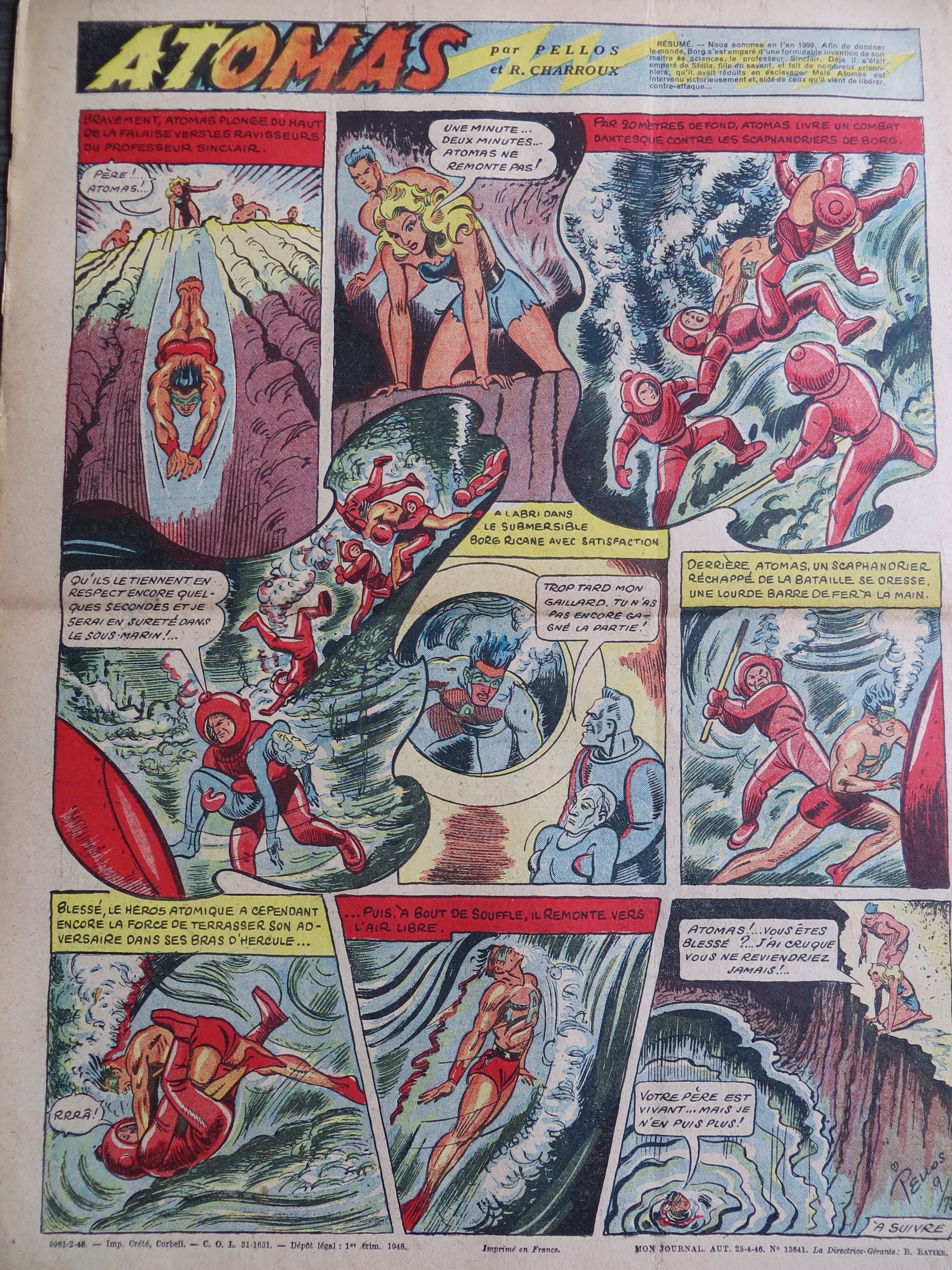
Panel 1
Caption:
Bravely, Atomas dives from the top of the cliff at Professor Sinclair’s kidnappers.
Bella: Father! Atomas!
Panel 2
Bella: One minute…two minutes…Atomas isn’t coming up!
Panel 3
Caption:
Twenty meters underwater, Atomas wages a Dantesque battle against Borg’s divers.
Panel 4
Borg: Let them keep him away for a few more seconds and I’ll be safe in the submarine!
Panel 5
Caption:
In the shelter of the submersible, Borg laughs with sneering satisfaction.
Borg: Too late, fellow, you haven’t won the game yet!
Panel 6
Caption:
Behind Atomas a diver, survivor of the battle looms up with a heavy iron bar in his hands.
Panel 7
Caption:
Though wounded, the atomic hero still has the strength to cast down his adversary with his Herculean arms…
Diver: Rrra!
Panel 8
Caption:
…then, out of breath, he rises towards fresh air.
Panel 9
Bella: Atomas?… Are you hurt?…I thought you’d never come back!
Atomas: Your father is alive…but I’m at the end of my strength!
Mon Journal No. 79, episode 10:
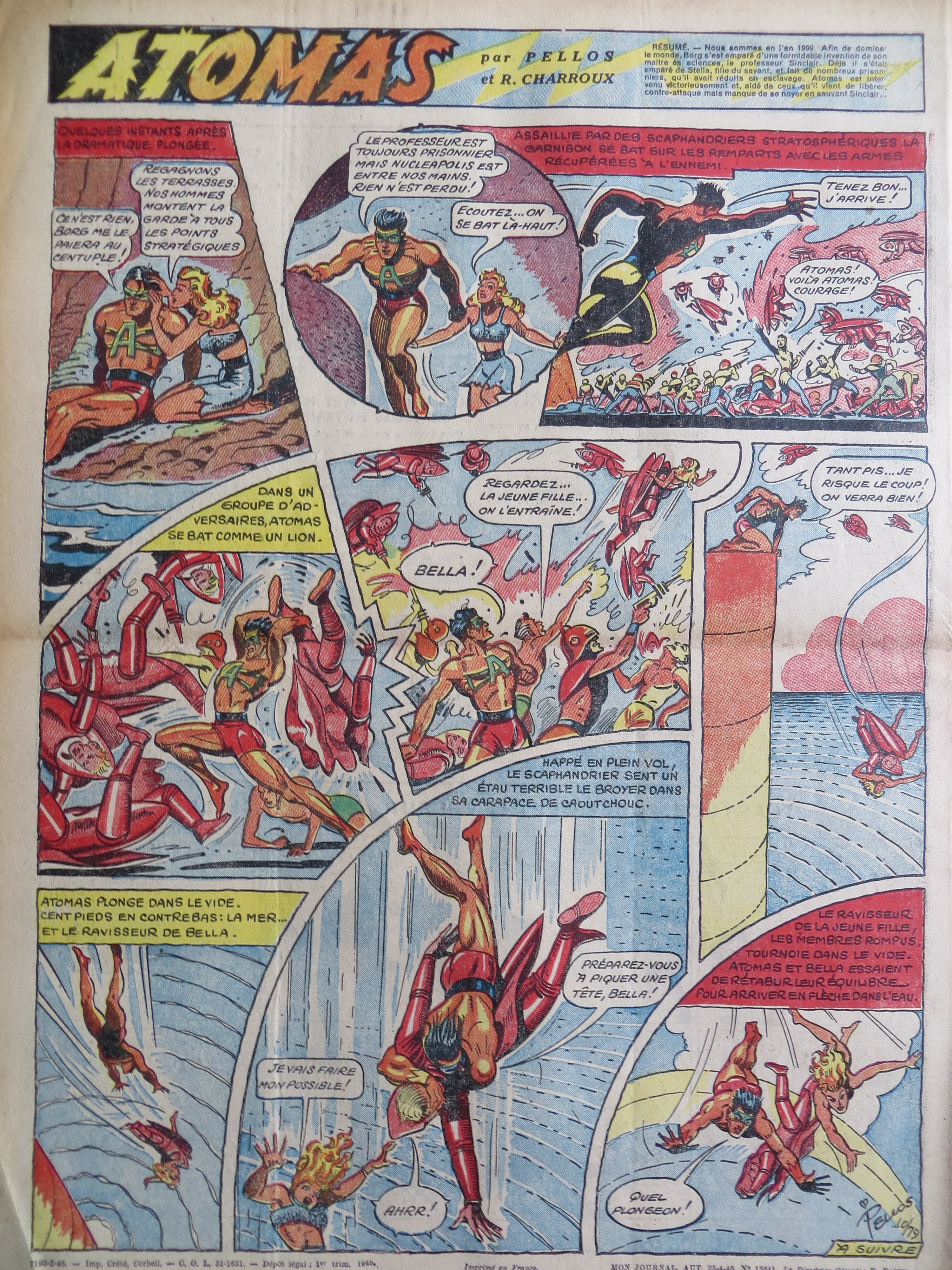
Panel 1
Caption:
Moments after the dramatic dive
Atomas: It’s nothing, Borg will pay for it a hundredfold!
Bella: Let’s go back to the terraces. Our men are mounting guard at the strategic points!
Panel 2
Atomas:The Professor is still a prisoner but Nucleapolis is in our hands. Nothing is lost!
Bella: Listen…there’s fighting up there!
Panel 3
Caption:
Assailed by stratospheric-armored men the garrison fights on the ramparts with the weapons taken from the enemy.
Atomas: Hold on, I’m coming!
Ex-captive: Atomas! Here’s Atomas! Courage!
Panel 4
Caption:
In one group of adversaries Atomas fights like a lion.
Panel 5
Ex-captive: Look! The young girl! They’re dragging her away!
Atomas: Bella!
Panel 6
Atomas: Too bad…I’ll risk it! We’ll see!
Panel 7
Caption:
Atomas dives into the void. A hundred feet lower: the sea…and Bella’s kidnapper.
Panel 8
Caption:
Seized in mid-air, the armored man feels a terrible vise crush his carapace of rubber
Atomas: Prepare for a head-first dive, Bella!
Bella: I’ll do what I can!
Bad guy: Ahrr!
Panel 9
Caption:
The young girl’s kidnapper, his limbs broken, tumbles through the void. Atomas and Bella try to restore their balance…to arrow into the water>
Atomas: What a dive!
[Artist Pellos’s skill at depicting human bodies in action probably is largely due to his main career—as a sports cartoonist for many decades.]
Mon Journal No. 80, episode 11:
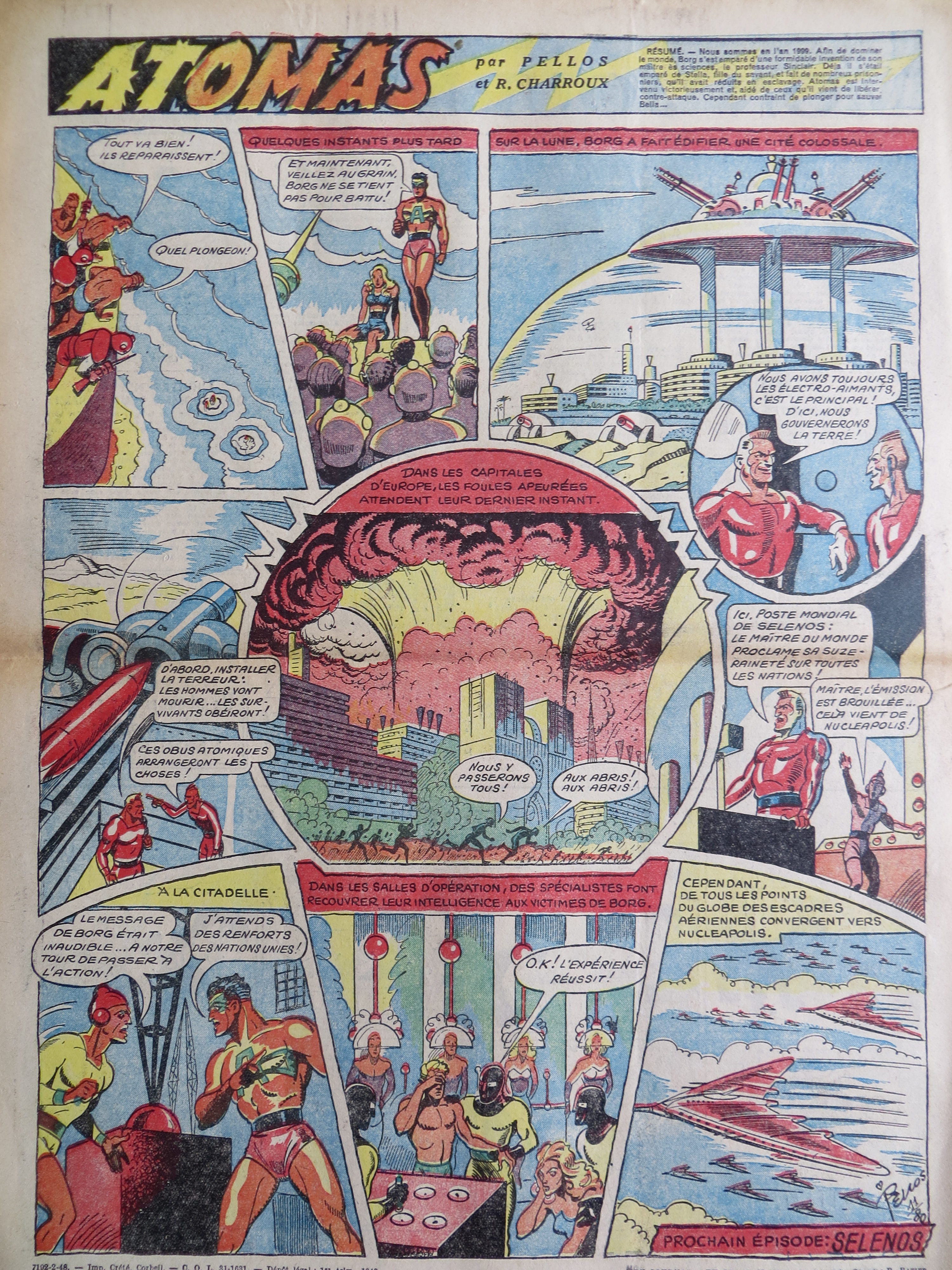
Panel 1
Ex-captive: Everything’s fine! They’re coming up!
Ex-captive 2: What a dive!
Panel 2
Caption:
A few moments later…
Atomas: And now, keep your eyes peeled! Borg doesn’t think he’s beaten!
Panel 3
Caption:
On the Moon, Borg has had a colossal city built.
Insert panel:
Borg: We still have the electro-magnets, that’s the main thing! From here, we’ll govern the Earth!
Panel 4
Borg: First, a reign of terror! Men will die…the survivors will obey!
Dan: These atomic bombshells will sort things out!
Panel 5
Caption:
In the capitals of Europe, the fearful crowds await their last moment.
Runner: We’ll all die!
Runner 2: To the shelters! To the shelters!
Panel 6
Borg: This is Selenos World Radio! The Master of the World declares his sovereignty over all nations!
Techie: Master, the broadcast is scrambled…this is coming from Nucleapolis!
Panel 7
Caption:
At the citadel…
Soldier: Borg’s message was inaudible…it’s our turn to take action!
Atomas: I’m expecting reinforcements from the United Nations!
Panel 8
Caption:
In the operating rooms, specialists have Borg’s victims recover their intelligence.
Doctor: O.K.! The experiment’s a success!
Panel 9
Caption:
Meanwhile, from all points of the globe, aerial squadrons are converging on Nucleapolis.
Mon Journal No. 81, episode 12:
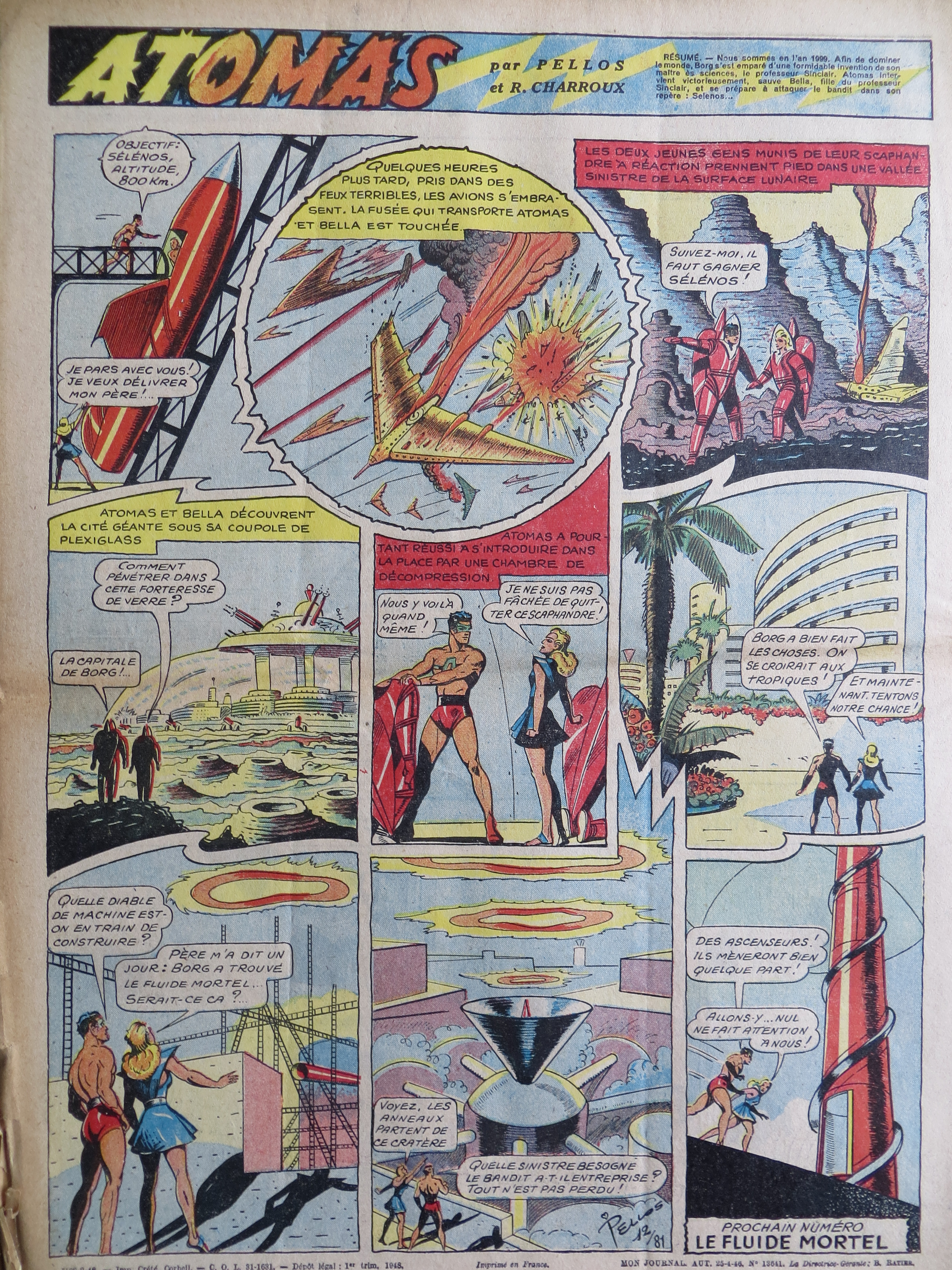
Panel 1
Atomas: Destination: Selenos! Altitude: 800 kilometers1
Bella: I’m going with you! I want to deliver my father!
Panel 2
Caption:
A few hours later, coming under terrible fire, the planes burst into flame. The rocket carrying Atomas and Bella is hit.
Panel 3
Caption:
The two youths clad in their jet-powered suits set foot on a sinister valley on the Moon’s surface.
Atomas: Follow me, we must get to Selenos!
Panel 4
Caption:
Atomas and Bella behold the giant city under its Plexiglas dome.
Atomas: Borg’s capital!
Bella: How can we get into a glass fortress?
Panel 5
Caption:
Yet Atomas has managed to enter the place through an airlock.
Atomas: Here we are, anyway!
Bella: I’m not unhappy at getting out of this suit!
Panel 6
Atomas: Borg’s done it up right. You’d think we were in the tropics!
Bella: And now, let’s try our luck!
Panel 7
Atomas: What the devil of a machine is being built?
Bella: Father told me one day: Borg has found the mortal fluid. Would that be it?
Panel 8
Bella: See, the rings come from this crater.
Atomas: What sinister work has the bandit undertaken? All is not lost!
Panel 9
Atomas: Elevators! They’ve got to lead somewhere!
Bella: Let’s go…nobody’s paying attention to us!
Caption:
Next issue: The Mortal Fluid
[I love how they set up, in panel 4, how challenging and dangerous it’ll be to enter the citadel – and then, in panel 5, ehh friggit, they just stroll in. Note that Bella joins Borg in complaining about the suit. They really should get an ergonomist to check it out.]
Mon Journal No. 82, episode 13:
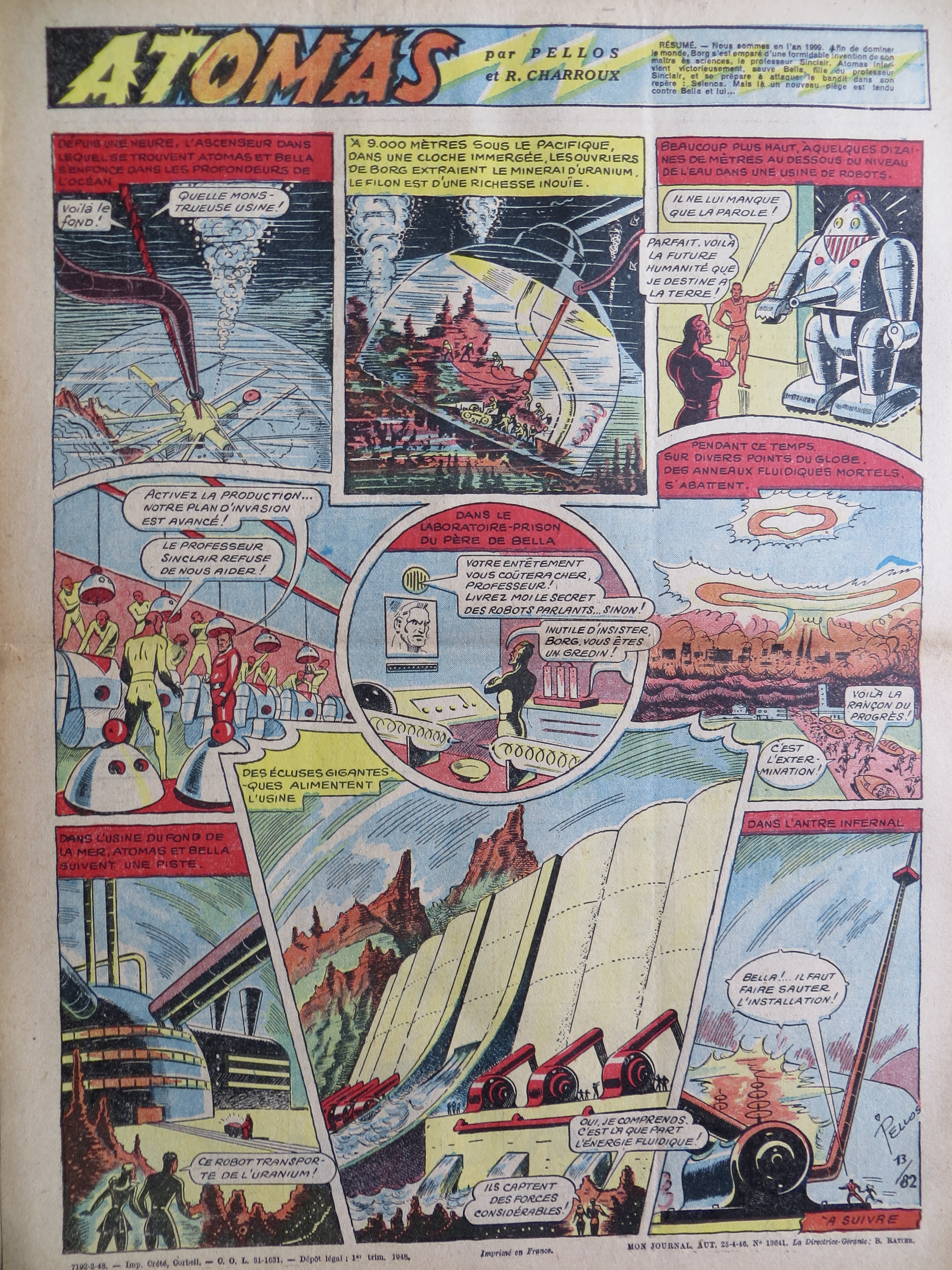
Panel 1
Caption :
For an hour, the elevator in which Atomas and Bella are descends into the depths of the ocean
Atomas: Here’s the sea-bottom!
Bella: What a monstrous factory!
Panel 2
Caption: At 9000 meters beneath the Pacific, in a submerged diving-bell, Borg’s workers extract uranium ore. The vein is incredibly rich.
Panel 3
Caption:
Far above, at some dozens of meters above sea-level, in a robot factory.
Dan: All he lacks is the power of speech!
Borg: Perfect, this is the humanity I intend for the Earth!
.
Panel 4
Borg: Activate production…our invasion plan has advanced!
Dan: Professor Sinclair refuses to help us!
Panel 5
Caption:
In the prison-laboratory of Bella’s father.
Borg: Your stubbornness will cost you dearly, Professor! Give me the secret of talking robots…or else…
Sinclair: It’s no use insisting, Borg, you’re a scoundrel!
Panel 6
Caption:
Meanwhile, at different points of the globe, lethal fluidic rings fall.
Runner: It’s the price of progress!
Runner 2: It’s extermination!
Panel 7
Caption:
In the factory at the bottom of the sea, Atomas and Bella follow a path.
Atomas: That robot’s transporting uranium!
Panel 8
Caption:
Giant locks supply energy to the factory.
Bella: They’re tapping considerable forces!
Atomas: Yes, I understand, it’s from there that the fluidic energy flows out!
Panel 9
Caption:
In the infernal lair
Atomas: Bella! We have to blow up this installation!
[Yet again, our heroes merely stroll into this top-security setup, taking in the sights like a tourist couple… Note the splendidly phlegmatic attitude of the chap in panel 6. “It’s the price of progress!” Shrugging through the apocalypse…typically French.]
Mon Journal No. 83, episode 14:
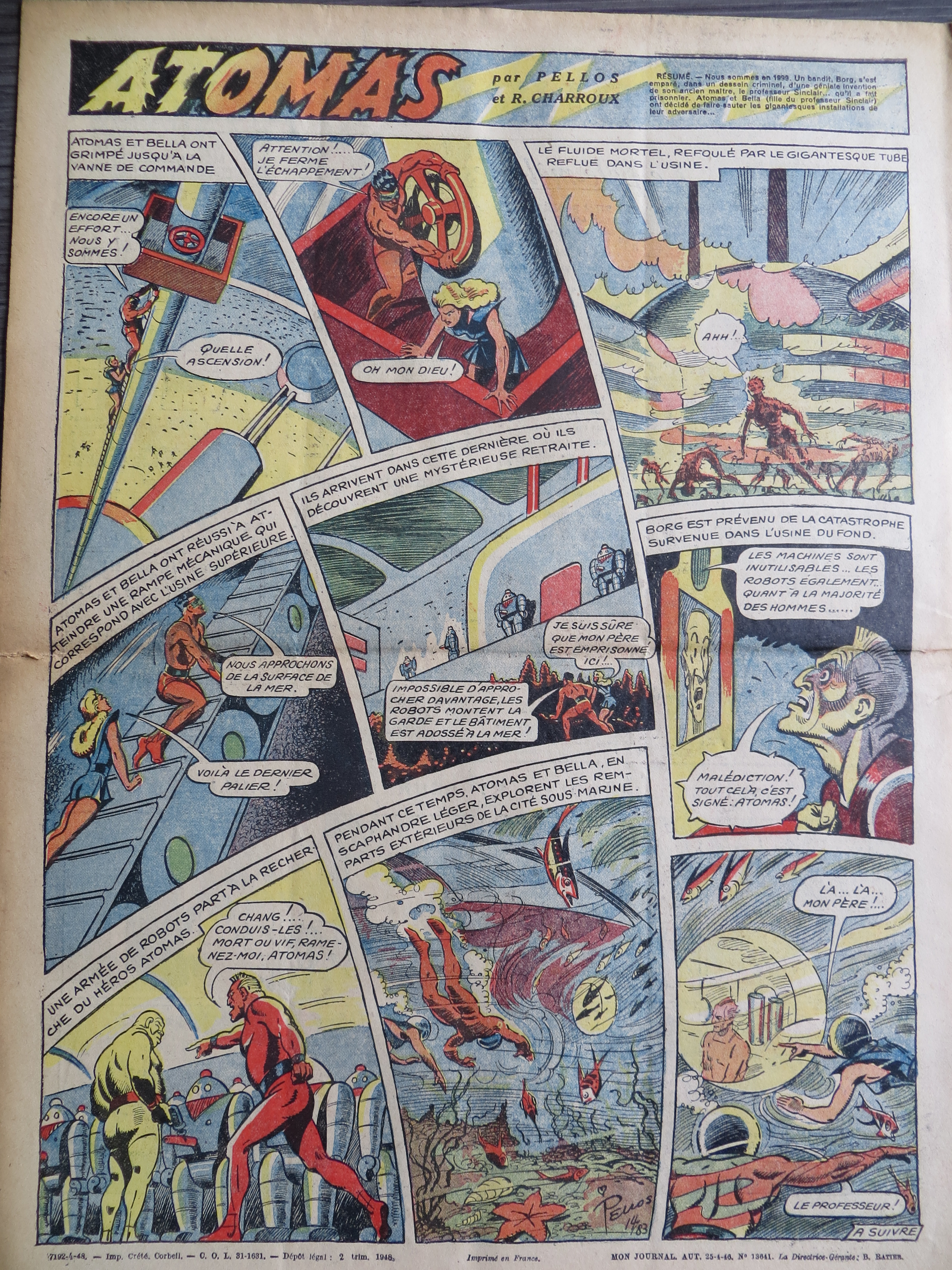
Panel 1
Caption:
Atomas and Bella have climbed up to the command valve.
Atomas: One more bit of effort and we’re there!
Bella: What a climb!
Panel 2
Atomas: Careful! I’m shutting off the escape valve!
Bella: Oh my God!
Panel 3
Caption:
The mortal fluid, turned back from the gigantic tube, flows into the factory.
Burning guy: Ahh!
Panel 4
Caption:
Atomas and Bella have managed to reach a mechanical ramp that links to the upper factory.
Atomas: We’re getting near the sea surface!
Bella: This is the last level!
Panel 5
Caption:
They arrive at that factory where they find a mysterious retreat.
Bella: I’m sure that my father is imprisoned here!
Atomas: Impossible to get any closer. The robots are mounting guard and the building is flush against the sea!
Panel 6
Caption:
Borg is told of the catastrophe striking the factory on the sea bottom.
Video guy: The machines are unusable…the robots too. As for most of the men…
Borg: Curses! All this is signed Atomas!
Panel 7
Caption:
An army of robots sets out in search of the hero Atomas.
Borg: Chang! Lead them! Dead or alive, bring me Atomas!
Panel 8
Caption:
Meanwhile, Atomas and Bella, clad in light diving suits, explore the outer ramparts of the submarine city.
Panel 9
Bella: There…there…my father!
Atomas: Professor!
[So evil henchman Chang returns in panel 7, and in the worst tradition of yellow peril racism is colored in a spectacular lemon hue. Apart from this dubious instance, however, I salute this strip for consistently excellent coloring, vibrant and expressive. Some color effects are so delicately done, like the iridescence on the bubble bombs in chapter 8, that I suspect artist Pellos is responsible.]
Mon Journal No. 84, episode 15:
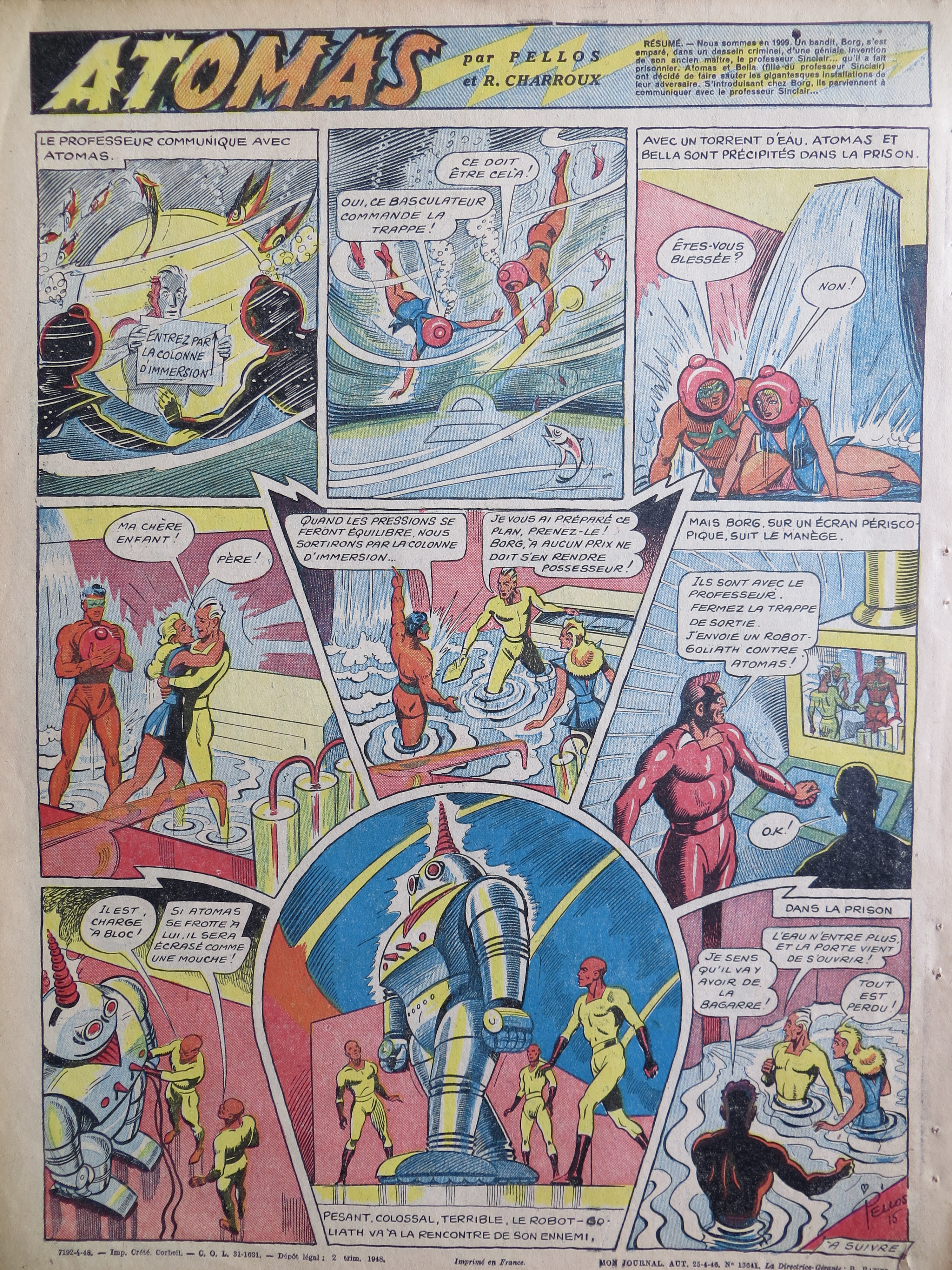
Panel 1
Caption:
The professor communicates with Atomas.
Sign: Enter through the immersion column
Panel 2
Atomas: It must be this!
Bella: Yes, this lever controls the trapdoor!
Panel 3
Caption:
With a torrent of water, Atomas and Bella are thrust into the prison.
Atomas: Are you injured?
Bella: No!
Panel 4
Professor: My dear child!
Bella: Father!
Panel 5
Atomas: When the pressures have equalized we’ll leave via the immersion column!
Professor: I’ve prepared this plan, take it! Borg must, at no price, ever possess it!
Panel 6
Caption:
But Borg, on a telescopic screen, follows these goings-on.
Borg: They’re with the professor. Close the exit trapdoor. I’m sending a Goliath Robot against Atomas!
Flunkie: O.K.!
Panel 7
Flunkie: It’s supercharged!
Flunkie’s pal:If Atomas messes with it he’ll be crushed like a fly!
Panel 8
Caption:
Heavy, colossal, terrible, the Goliath Robot goes to face its enemy.
Panel 9
Caption:
In the prison
Professor: The water’s no longer entering and the door’s opened!
Bella: All is lost!
Atomas: I feel there’s going to be a brawl!
Mon Journal No. 85, episode 16:
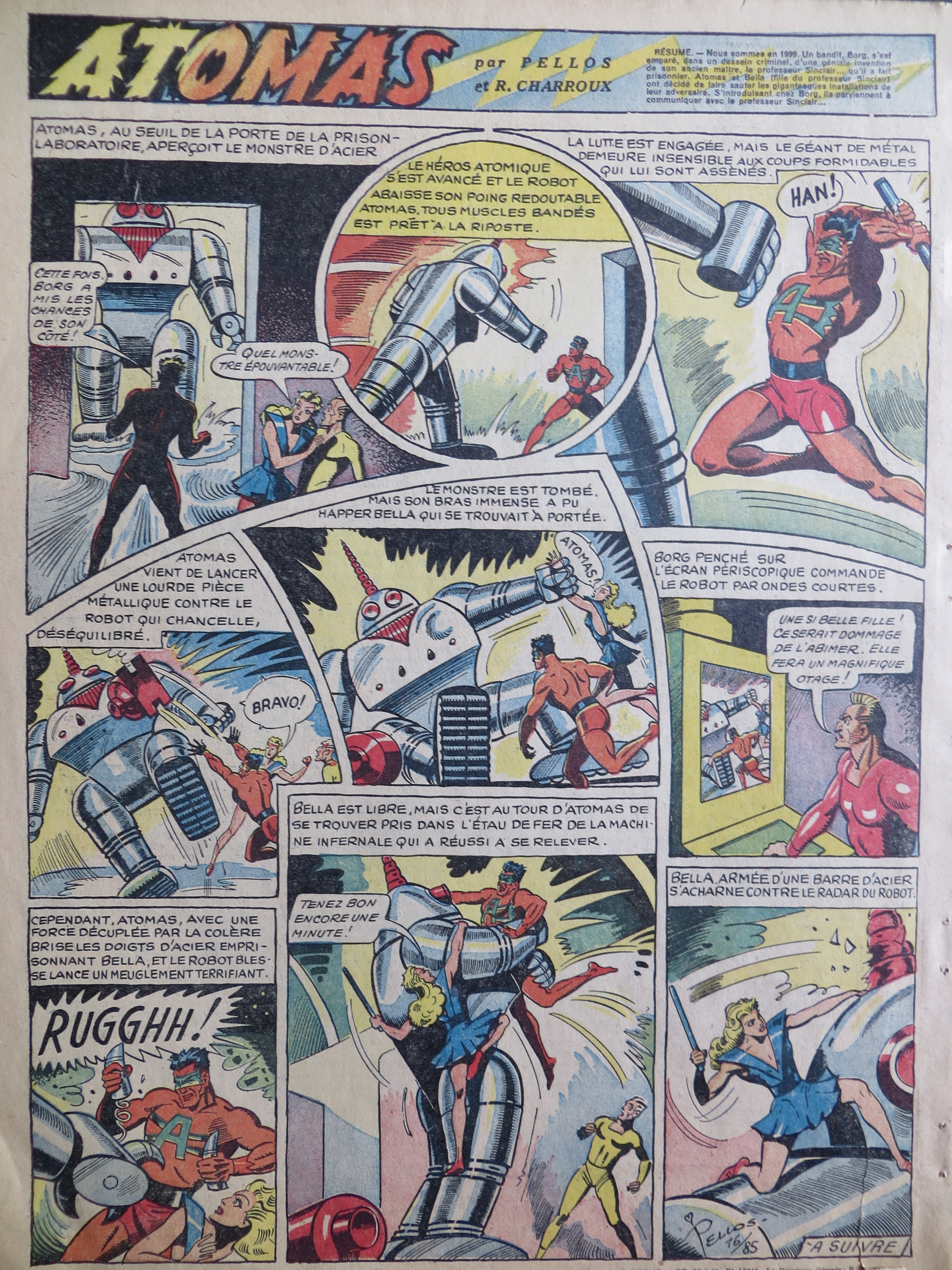
Panel 1
Caption:
Atomas, at the threshold of the laboratory’s door, sees the steel monster.
Atomas: This time, Borg’s tipped the scales of luck!
Bella: What a horrible monster!
Panel 2
Caption:
The atomic hero steps forth and the robot lowers its fearsome fist. Atomas, muscles clenched, is ready to strike back.
Panel 3
Caption:
The battle is on. But the metal giant remains insensible to the formidable blows rained on it.
Atomas: Hhahn!
Panel 4
Caption:
Atomas has just thrown a heavy metal part against the robot that teeters, unbalanced…
Panel 5
Caption:
The monster has fallen. But its immense arm was able to grab Bella who was in its reach.
Bella: Atomas!
Panel 6
Caption:
Borg, leaning toward his periscopic screen, commands the robot via shortwave.
Borg: Such a lovely girl! It’d be a shame to damage her. She’ll make a magnificent hostage!
Panel 7
Caption:
Meanwhile Atomas, his strength grown tenfold by anger, breaks the steel fingers imprisoning Bella, and the injured robot bellows terrifyingly…
Robot: RUUGGH!
Panel 8
Caption:
Bella is free, but it’s Atomas’ turn to be caught in the steel vise of the infernal machine that has managed to get up.
Bella: Hold on one more minute!
Panel 9
Caption:
Bella, armed with a steel rod, beats relentlessly on the robot’s radar.
And so unfortunately the story ends, although it’s refreshing to see Bella stop screaming and start kicking robot ass! If my comments often were sarcastic, please don’t think my attitude towards this strip was one of indulgence in camp. With all its zaniness, ‘’Atomas” is a crackerjack thriller with the pace of a jet plane, a delight for every boy and girl, every week…while it lasted.
Hats off to artist Pellos! His work here has nothing to envy that of his 1947 fellow superhero artists across the Atlantic. Pellos had a remarkable career (from 1916 to 1981) and found success in genres ranging from sports cartooning to humor strips to science fiction – his 1938 strip Futuropolis is deemed the first French s.f. comic. Bravo, Monsieur Pellos!
–Alex Buchet
(Note from Chris: And as a special bonus, here’s the worst selfie ever taken on my wife’s cellphone:
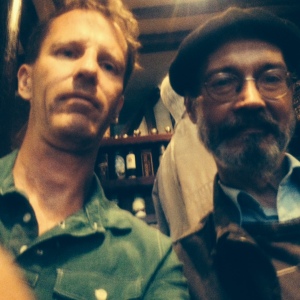
[That’s Chris on the left and me on the right — Alex]




















